2021 Bicycle-Kayak Tour
Newport to Yorktown -- Aug 21-27
| Links to Days
Aug 21: NJ -- Princeton Aug 22: PA -- Philadelphia Aug 23: DE -- Stanton Aug 24: MD -- Havre de Grace Aug 25: MD -- Baltimore Aug 26: MD -- Annapolis Aug 27: VA -- Mount Vernon |
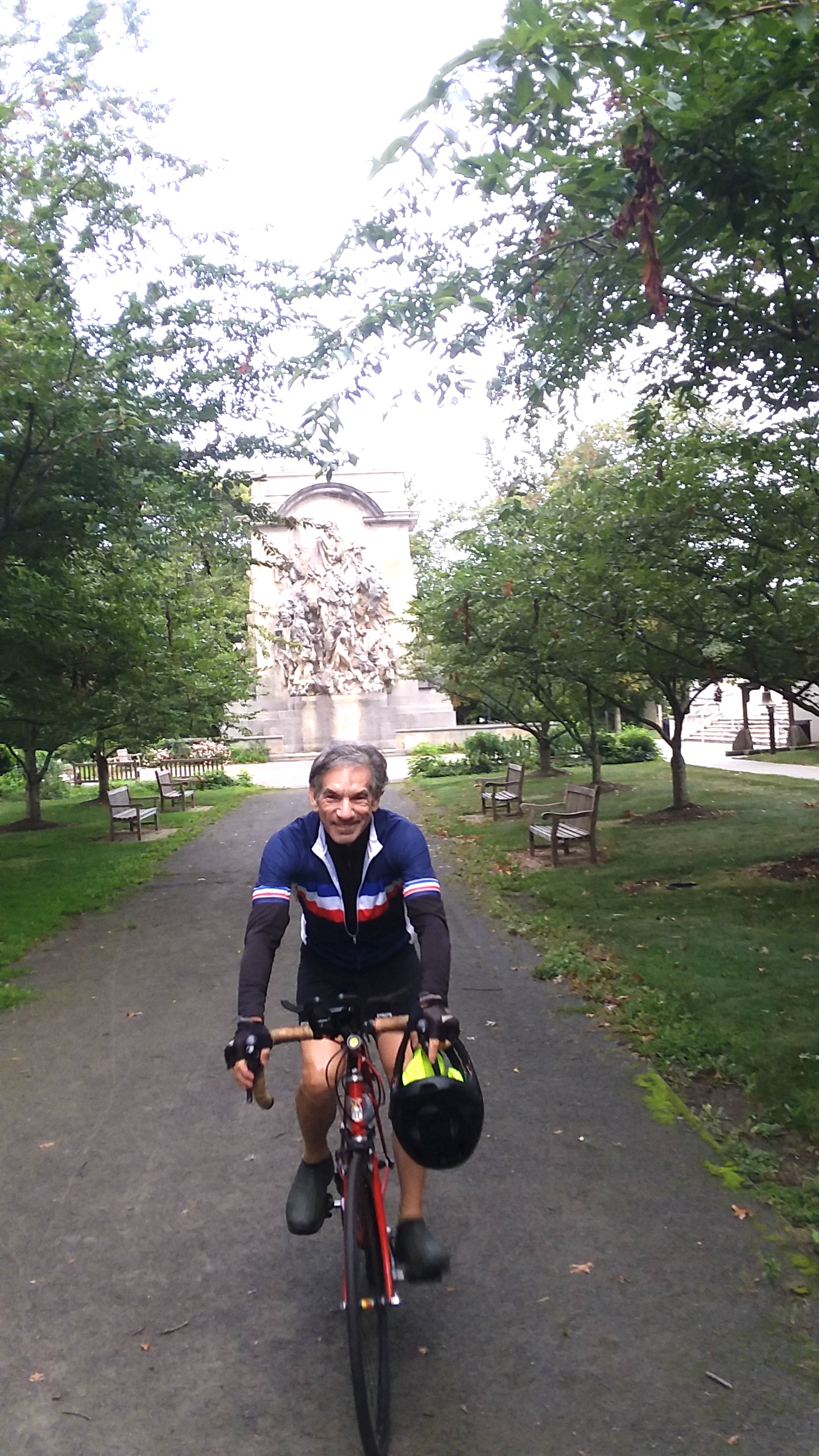
We began with a farewell photo of the Princeton Battle Monument
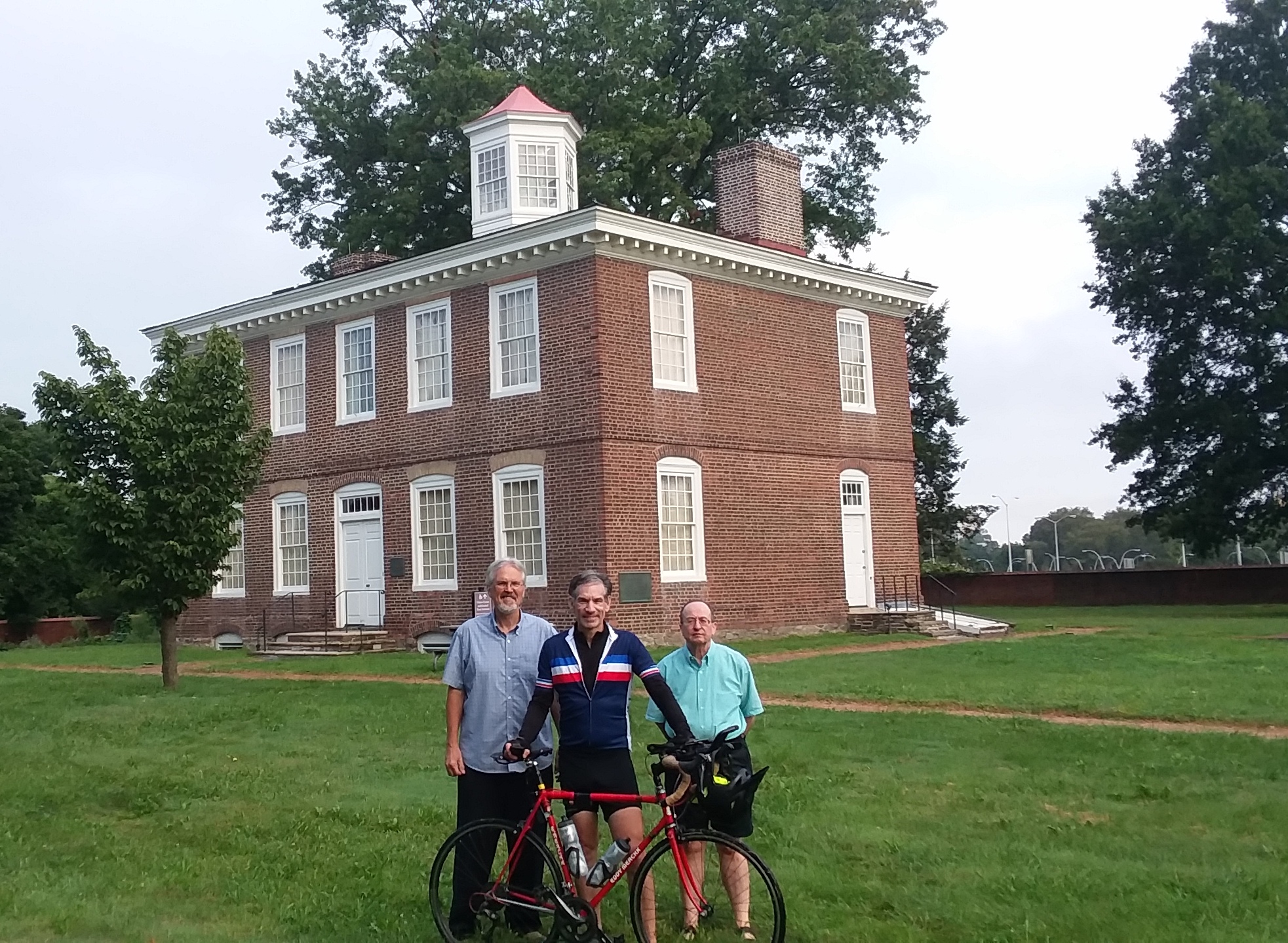
then went to the Trent House in Trenton, built in 1719,
where Sal was welcomed by Paul Larson (left)
and W3R®-US Leadership Council member Sam Stephens (right).
| Then we entered Pennsylvania, where, at Sal's suggestion, Jeff drove straight to Valley Forge National Historical Park rather than try to follow him through the narrow, congested streets of central Philadelphia. The next scheduled activity was not until 2:30 PM, so Jeff had time to buy a few books in the gift shop and take a self-guided driving tour of the park. |
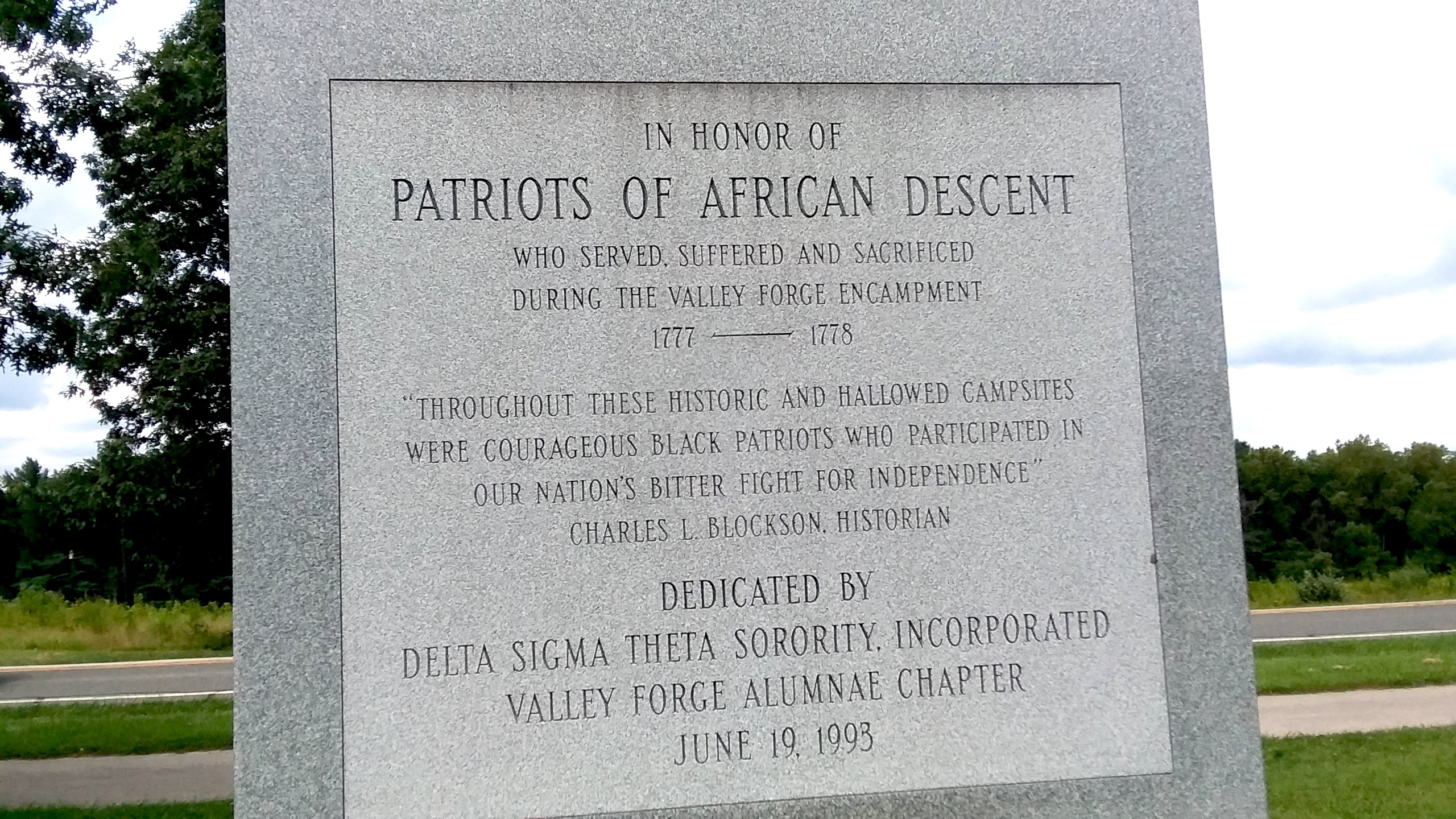
The ceremony was held at the Patriots of African Descent Monument,
erected in 1993 by the Valley Forge Alumnae Chapter of Delta Sigma Theta Sorority, Inc.
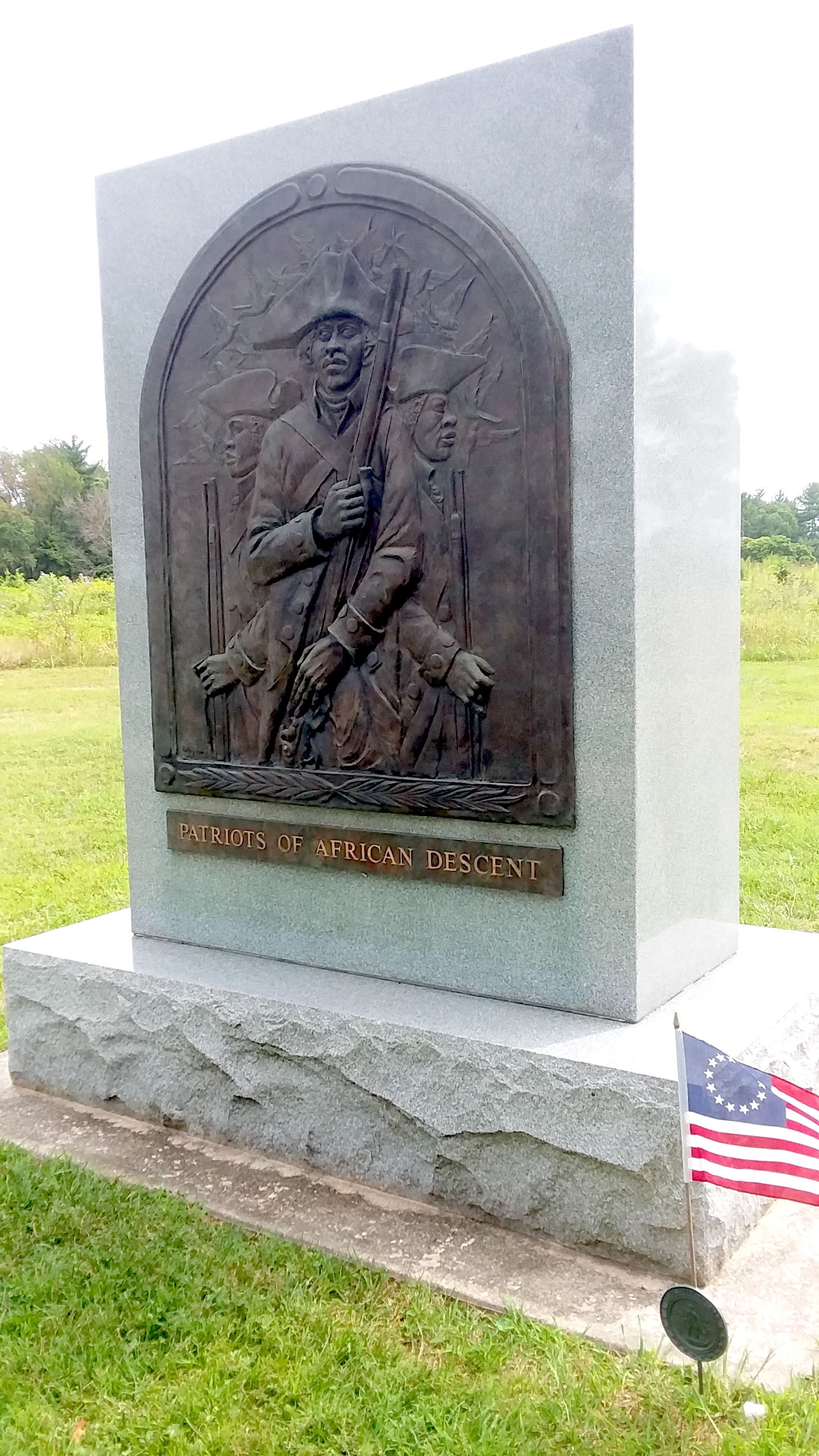
The other side of the monument.
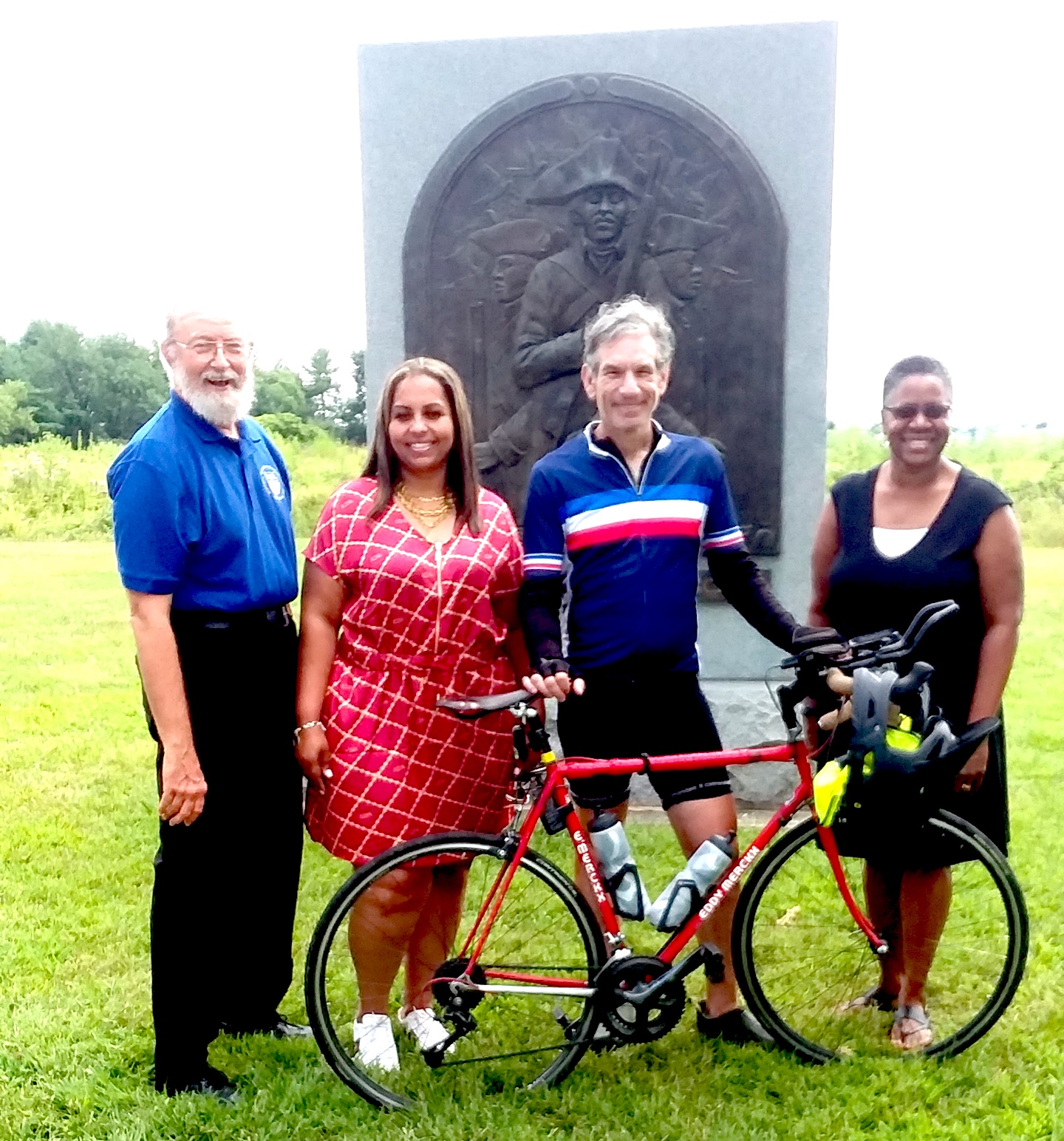
Jeff, Mandel Smith , chair of the sorority' s Patriots Committee, Sal,
and committee member Bonique Thompson-Harris.
| Mandel shared the story of the monument, the first in a national park to commemorate patriots of African descent who served in the Revolutionary War. Three different images represent the societal roles of Colonial Blacks and their purpose in joining the struggle for independence - free men who volunteered to fight, slaves who received freedom as payment for their service, and slaves who served as soldier substitutes for their masters or attended them on the battlefield, only to return to their previous condition of servitude after the war. Sal noted the importance of sharing with the general public these unfamiliar stories of the war. |
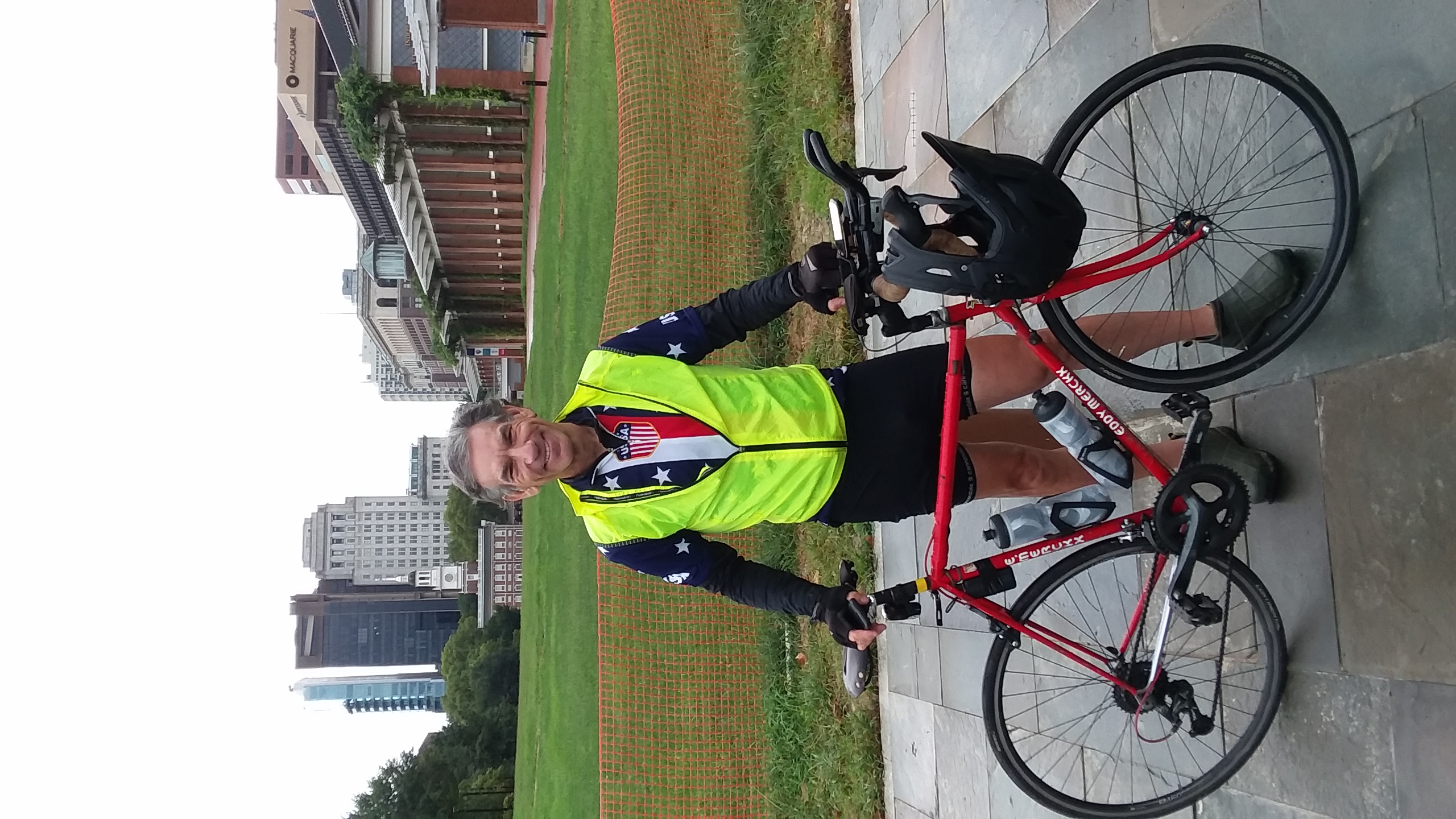
Sal began bicycling south at Independence Hall (to the left of Jeff's head),
where on September 4, 1781, the French and Continental troops
passed in review before the Confederation Congress.
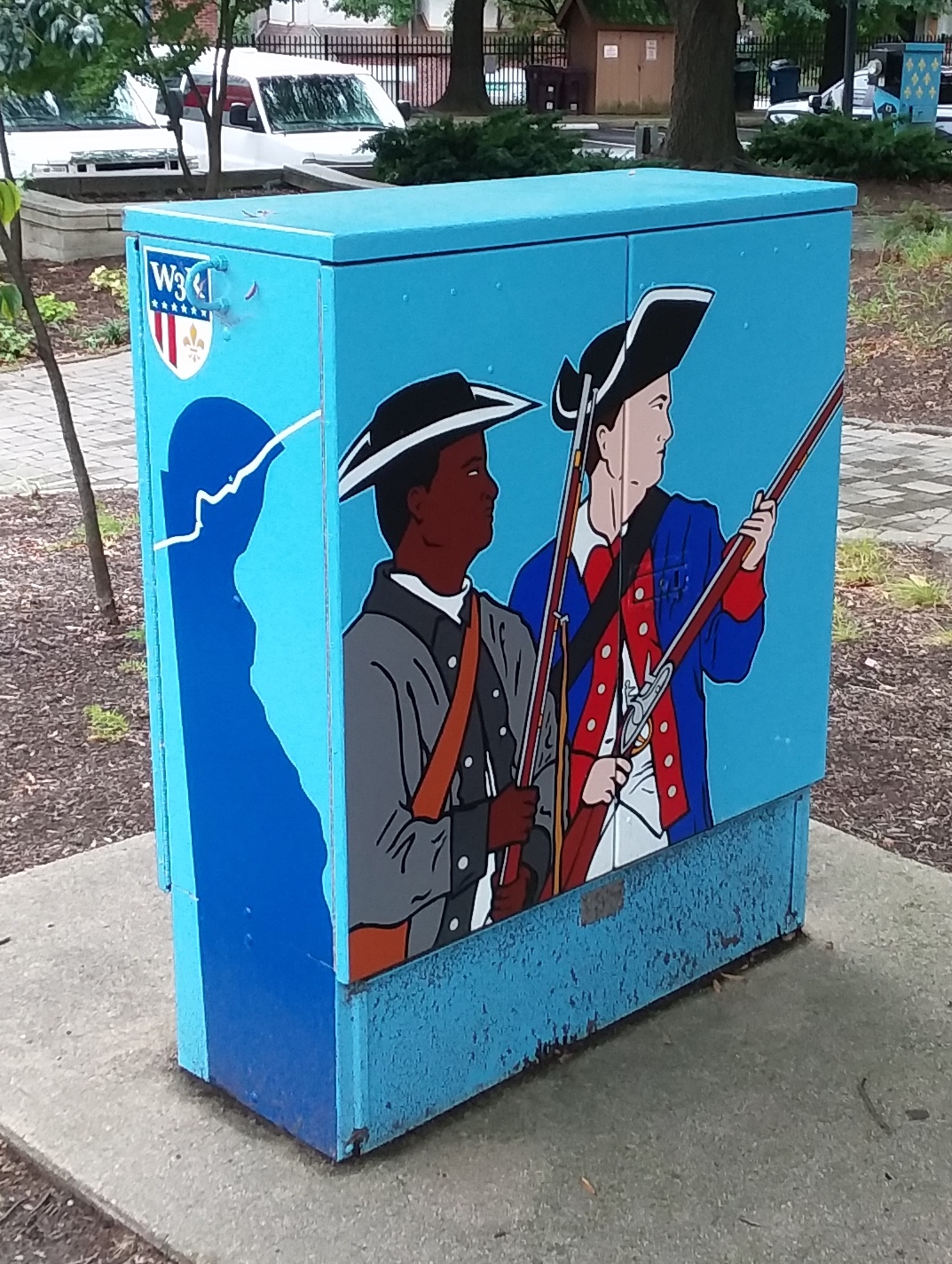
30 miles later, at Brandywine Village Plaza in Wilmington DE,
Sal passed murals showing the diversity of the Continental Army,
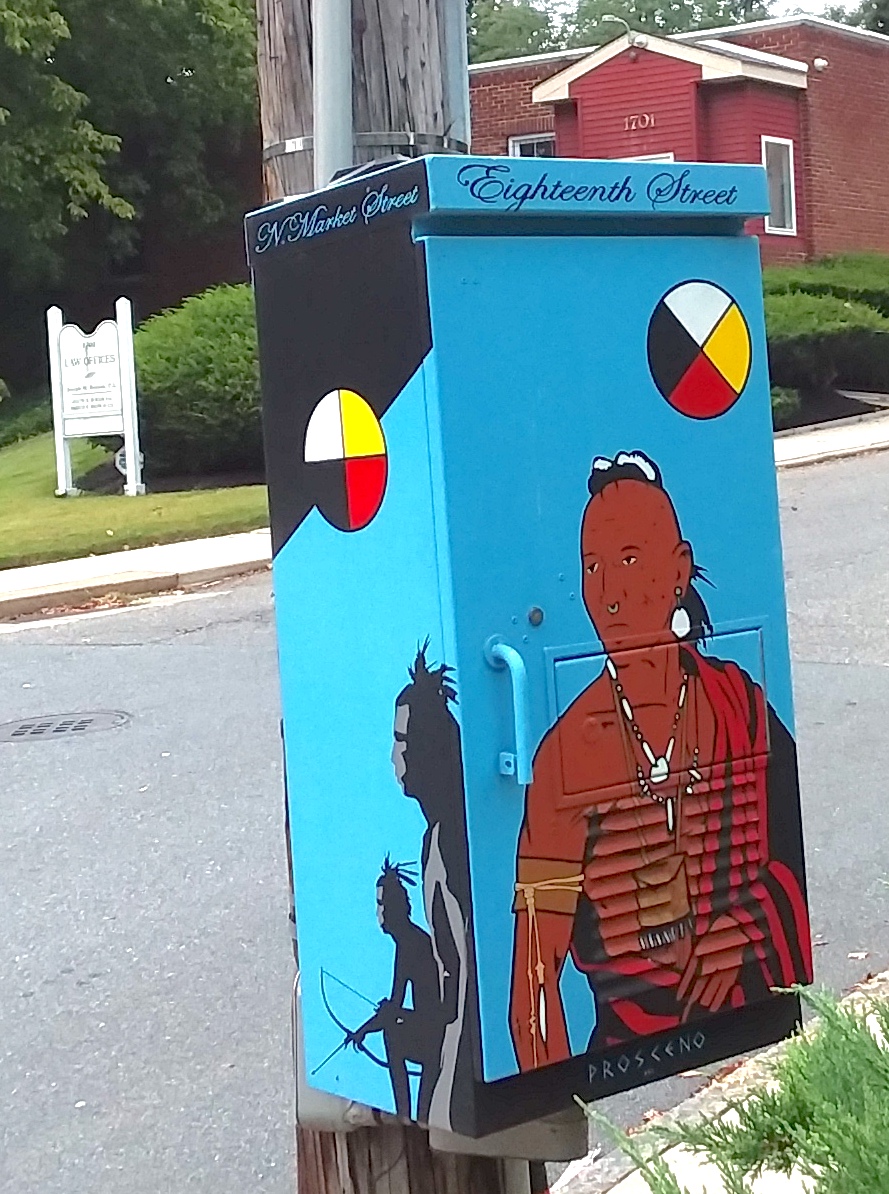
whose ranks included Lenape scouts,
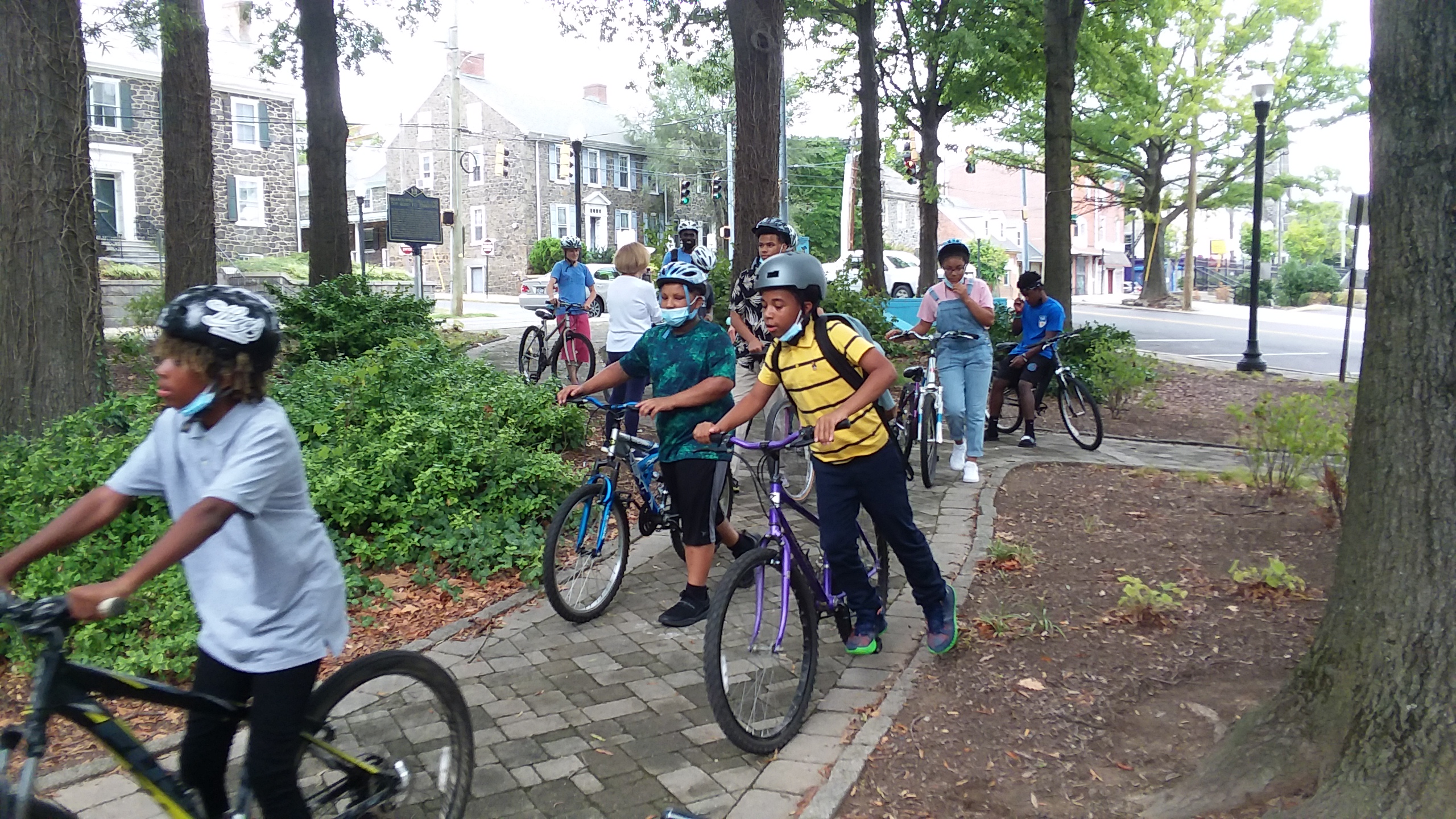
Fifteen young cyclists from the Urban Promise Academy arrived at noon.
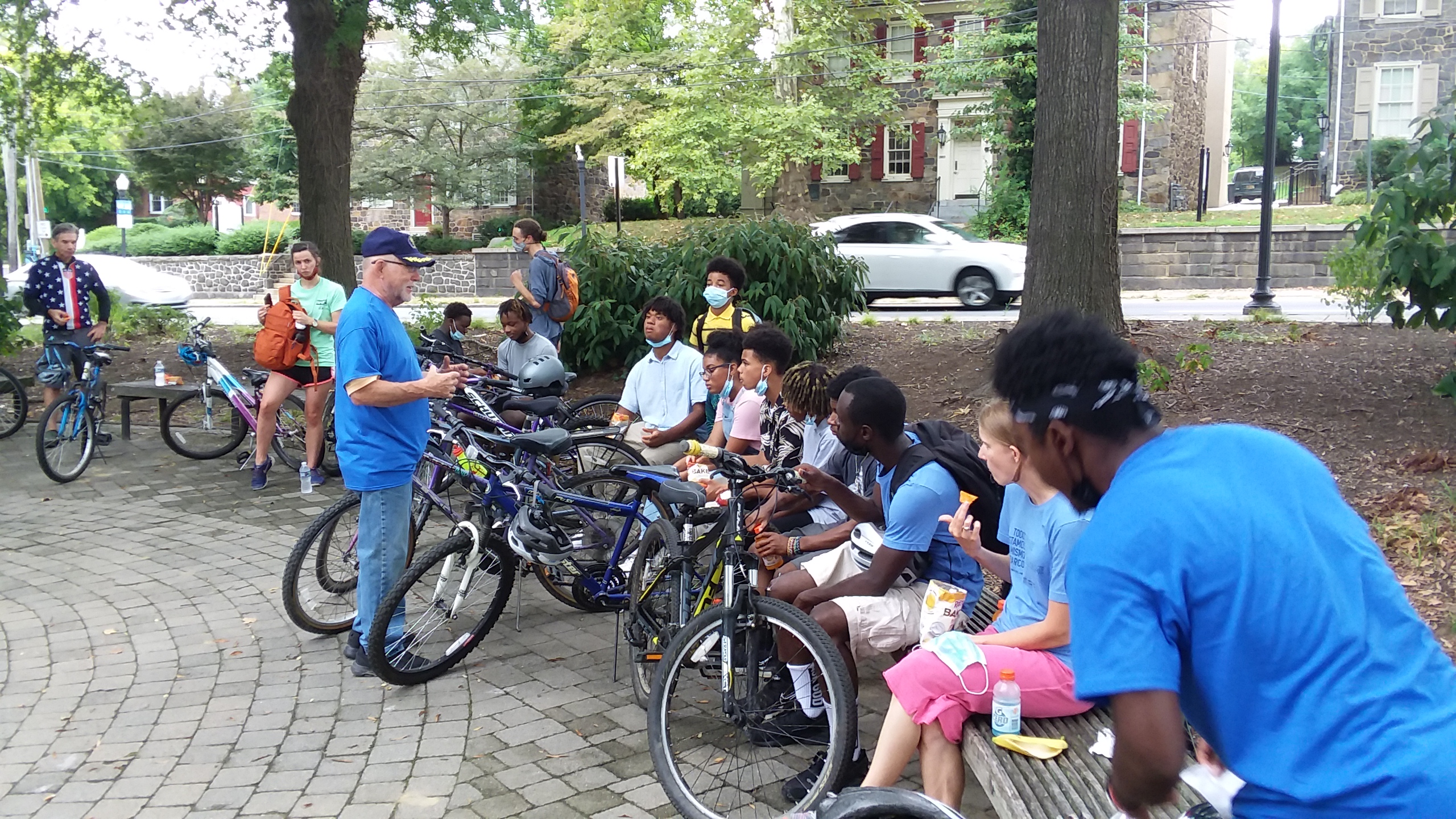
Bill Conley, chair of W3R®-DE, discussed the diversity of the army
that passed this site in 1781 (going south) and 1782 (returning north).
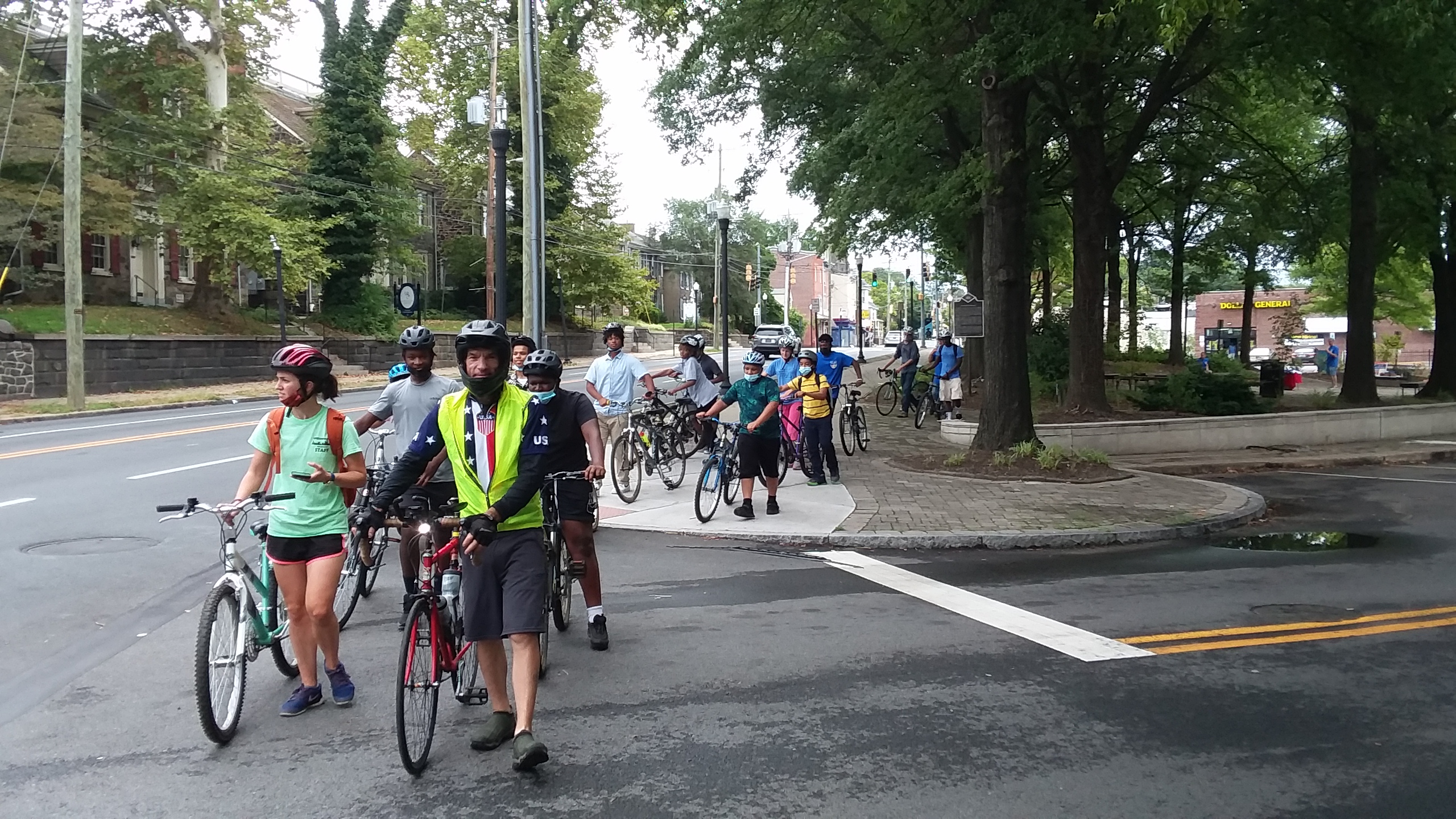
Sal led the young cyclists
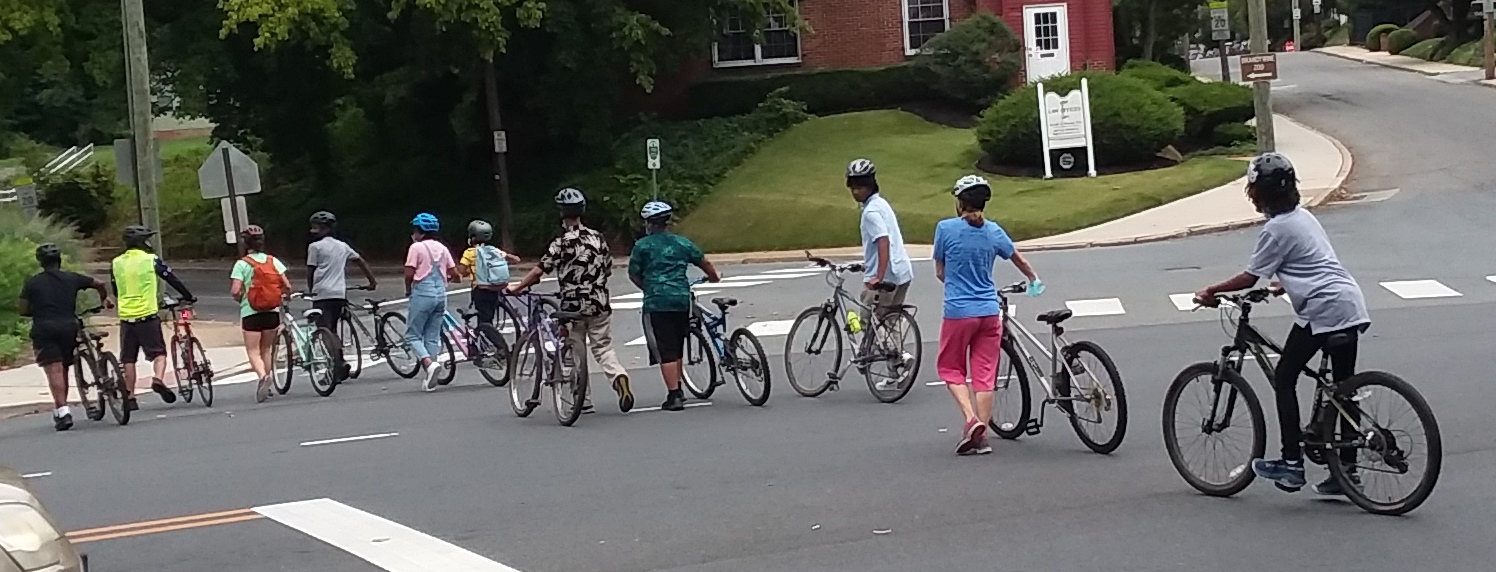
on a 45-minute ride around the Village
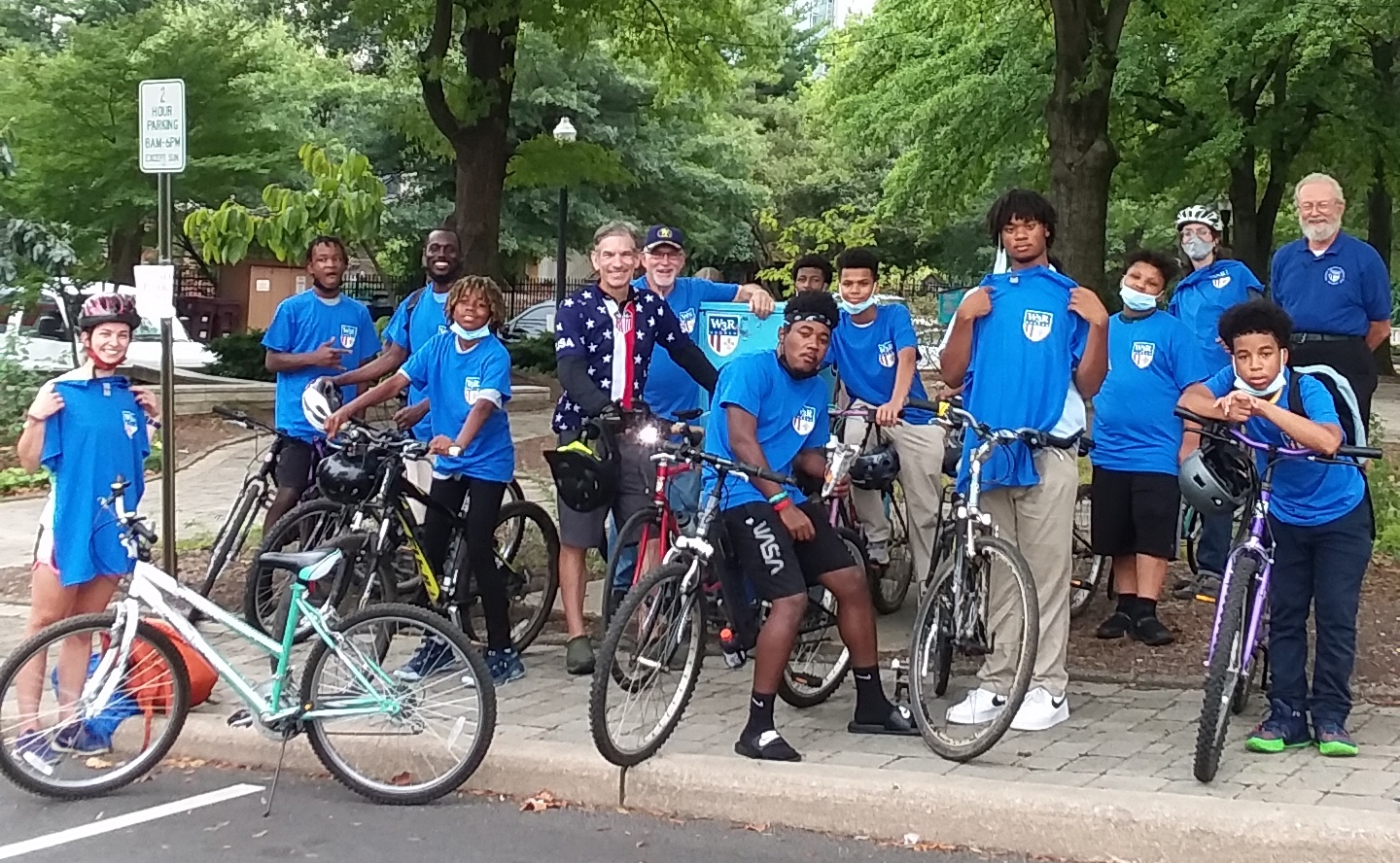
after which the youth received blue W3R® tee-shirts
| Sal then bicycled to the Hale-Byrnes House in Stanton DE. Here in 1777, shortly before the nearby Battle of Cooch's Bridge, Lafayette (then an aide de camp to General Washington) had his 19th birthday. Behind the house former W3R®-US Chair Kim Burdick hosted a dinner for 30 people. |
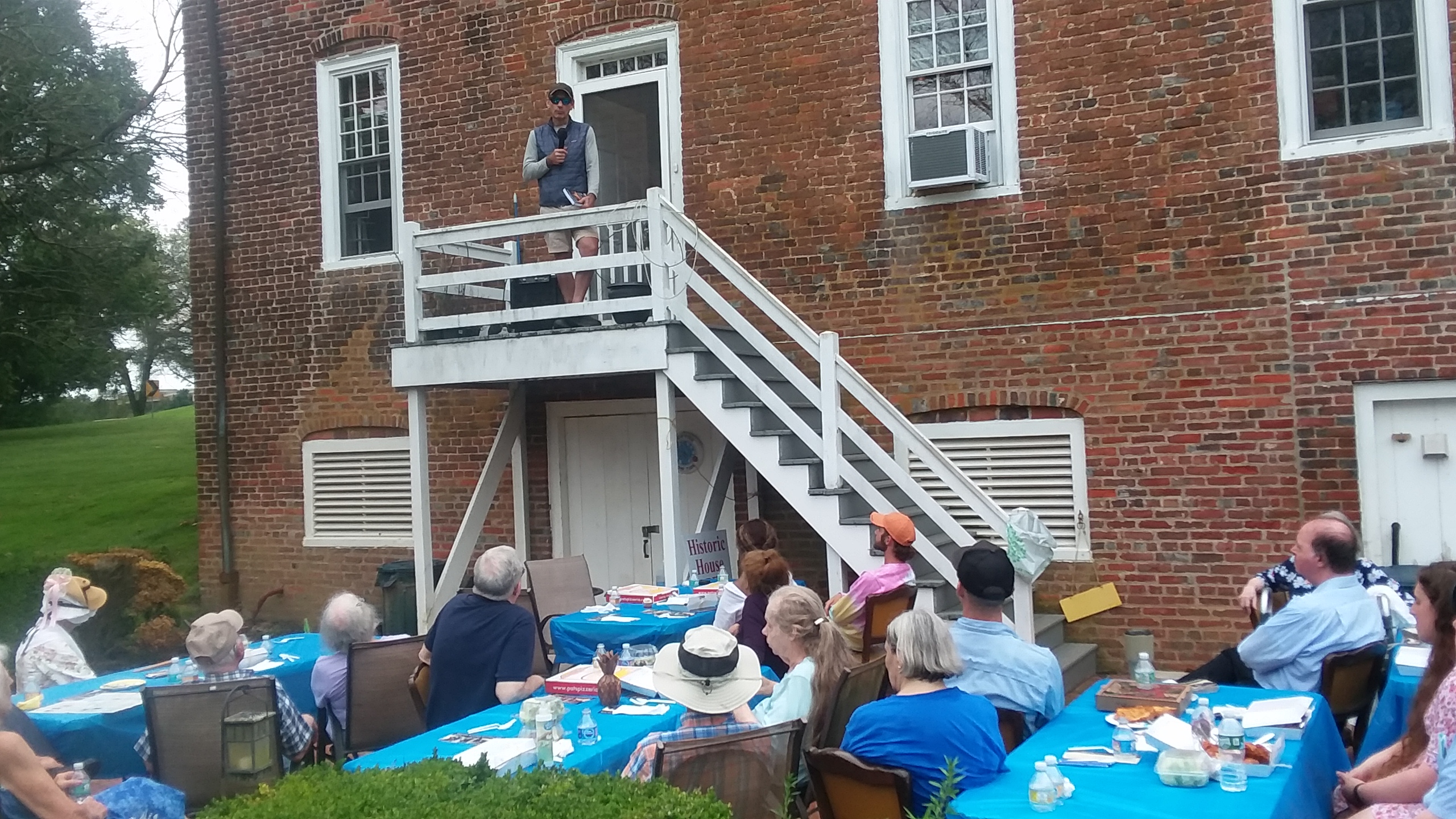
Sal and Jeff spoke about the 240th Anniversary Tour and its significance
in highlighting little-known stories of the 1781 Allied March to Yorktown. .
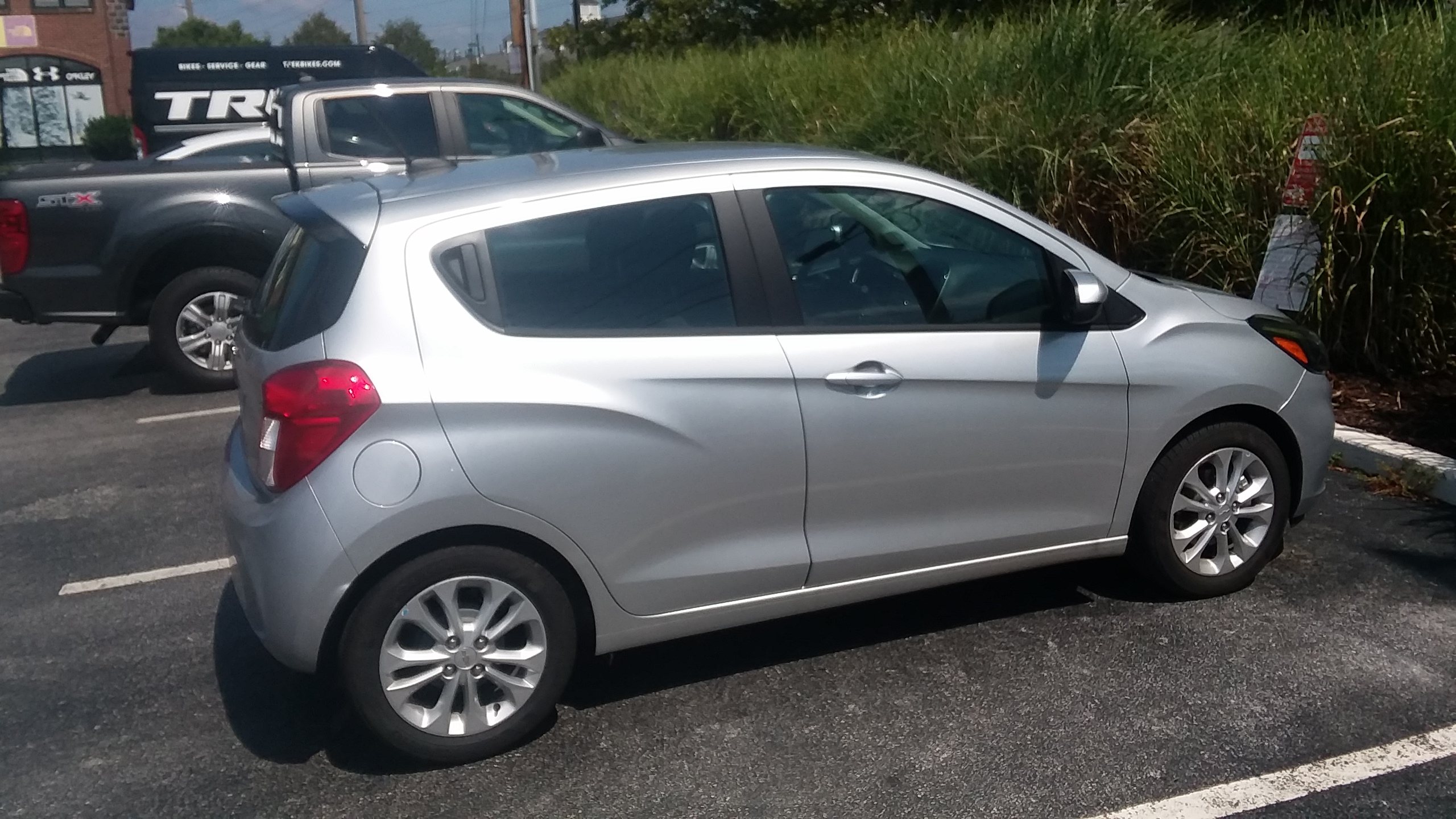
to a car rental agency to get a Chevy Spark for a support vehicle.
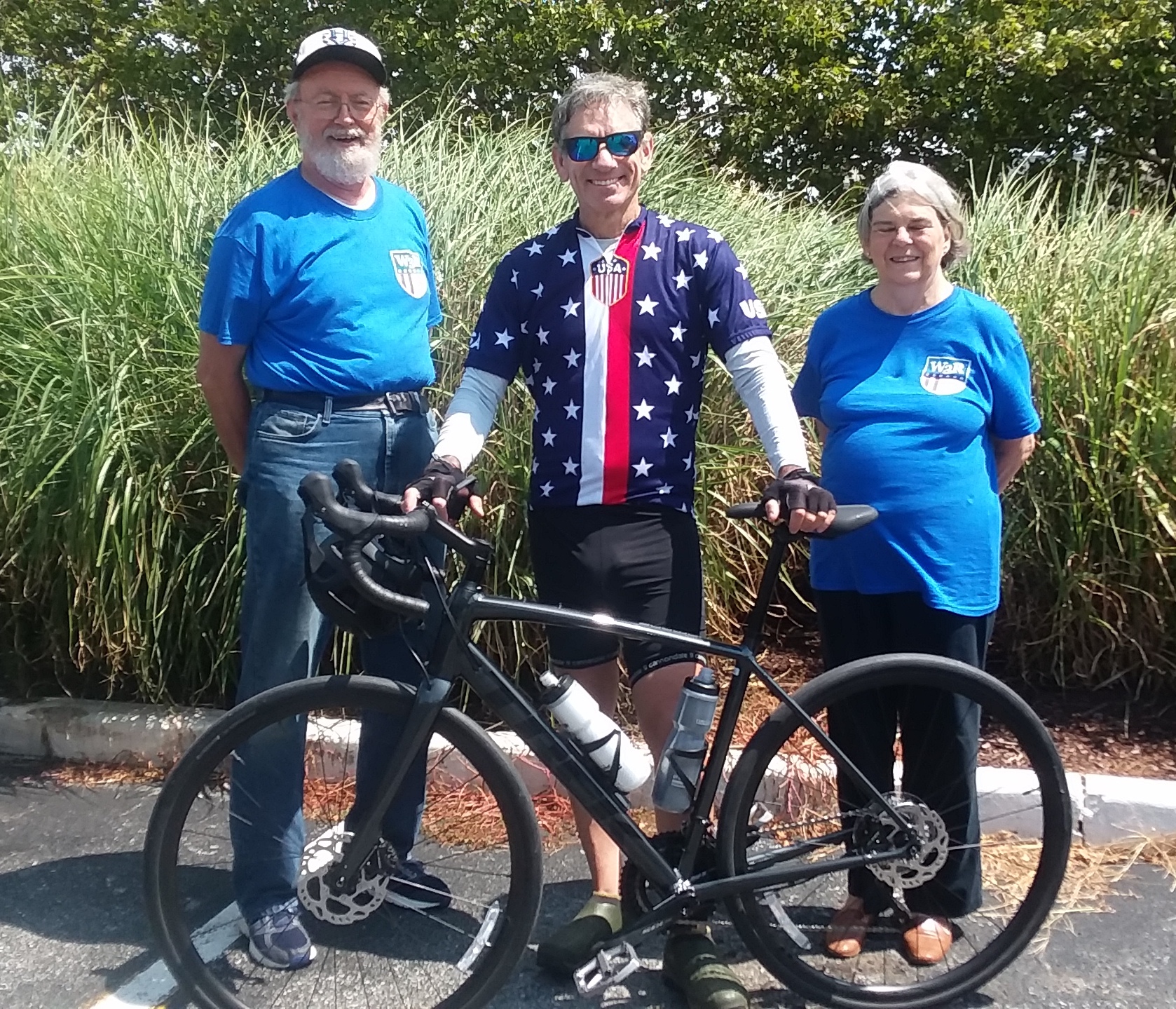
and to Trek Bicycle in Newark, Delaware, to get a new bike.
Happy Jeff --- Happy Sal --- Helpful Kim !
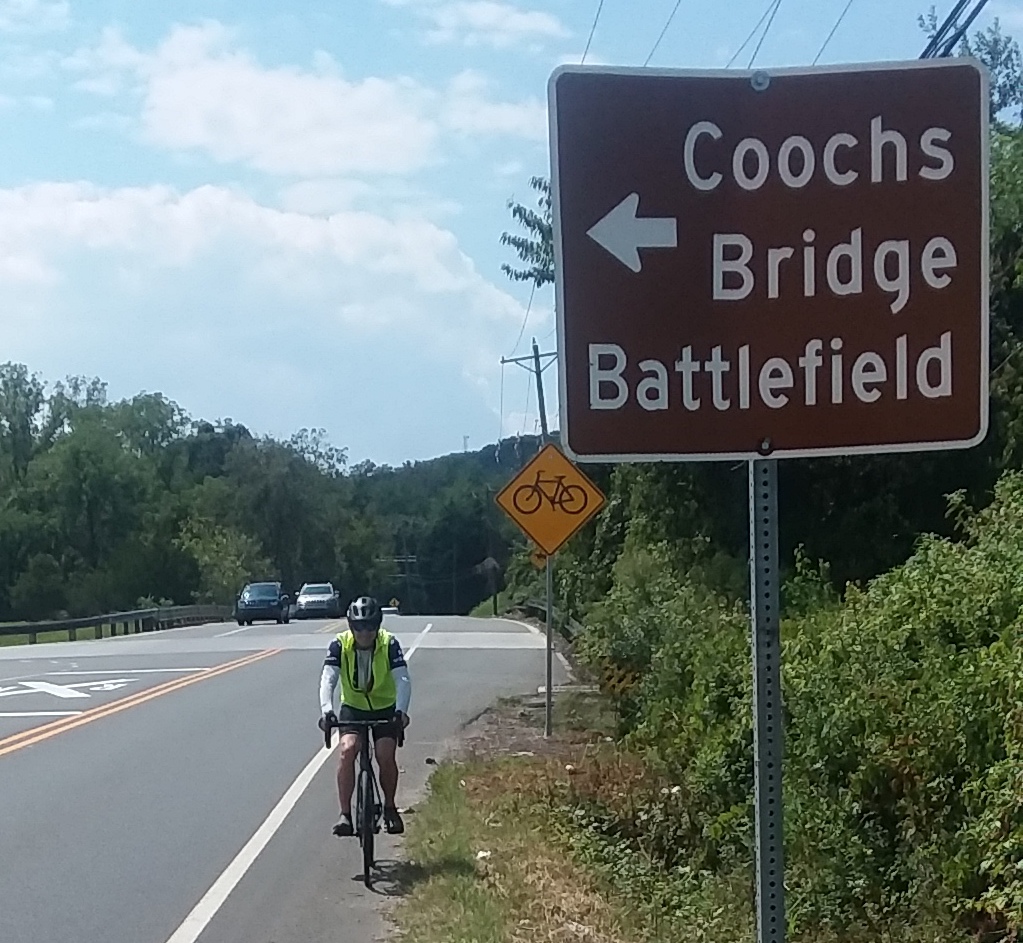
Sal's first stop was the site of the Battle of Cooch's Bridge (over the rise behind Sal),
the only Revolutionary War battle in Delaware. This brief, but intense, engagement
between Continental and British troops, on Sept. 3, 1777, was the opening chapter
of the Philadelphia campaign, which included the Battles of Brandywine and Germantown
and the British seizure of Philadelphia, then the U.S. capitol.
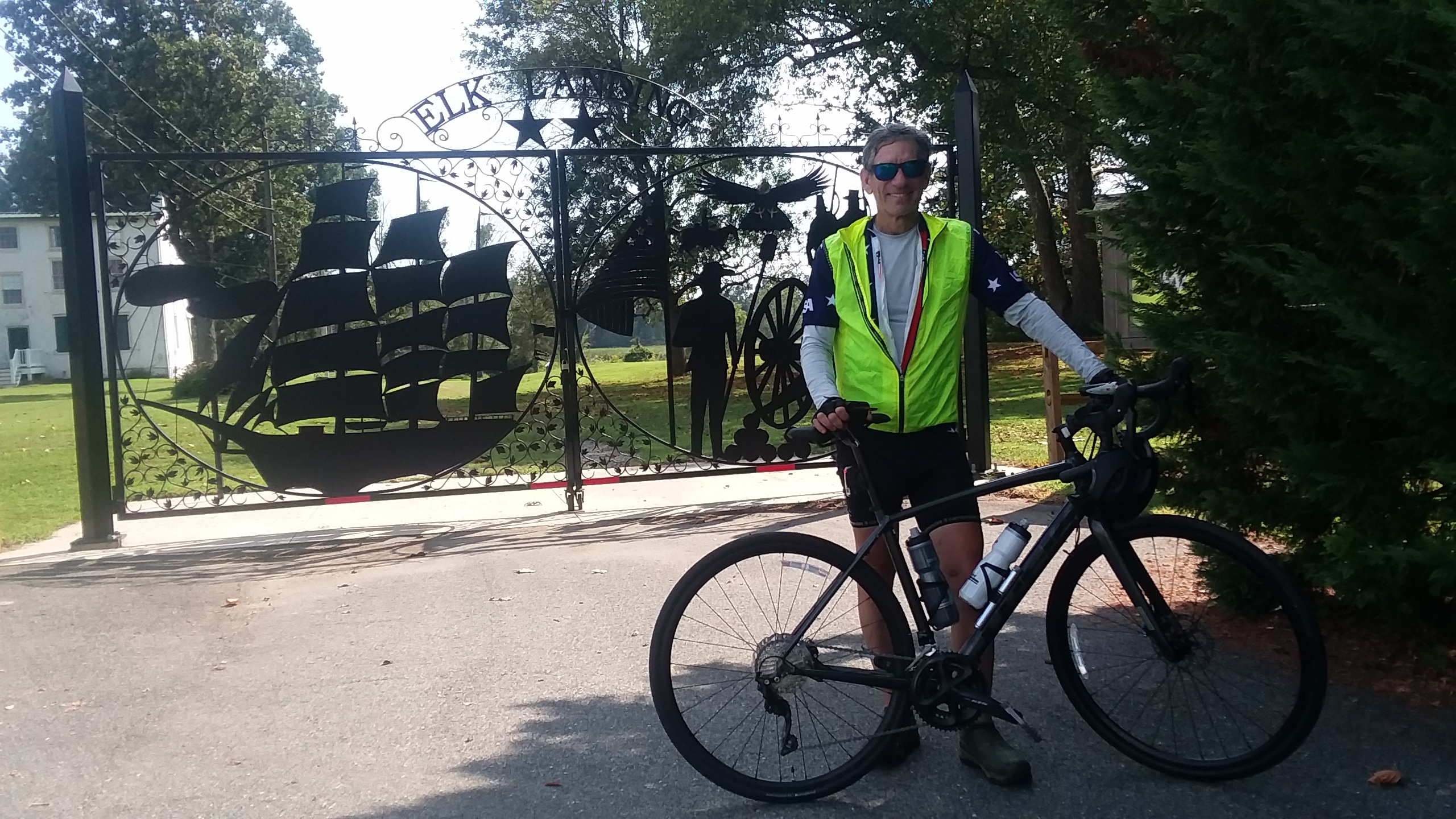
His next stop was Elkton Landing / Head of Elk in Maryland,
In 1781 many French and Continental soldiers embarked here on troopships
to sail down the Chesapeake Bay and up the James River to offload at Jamestown VA.
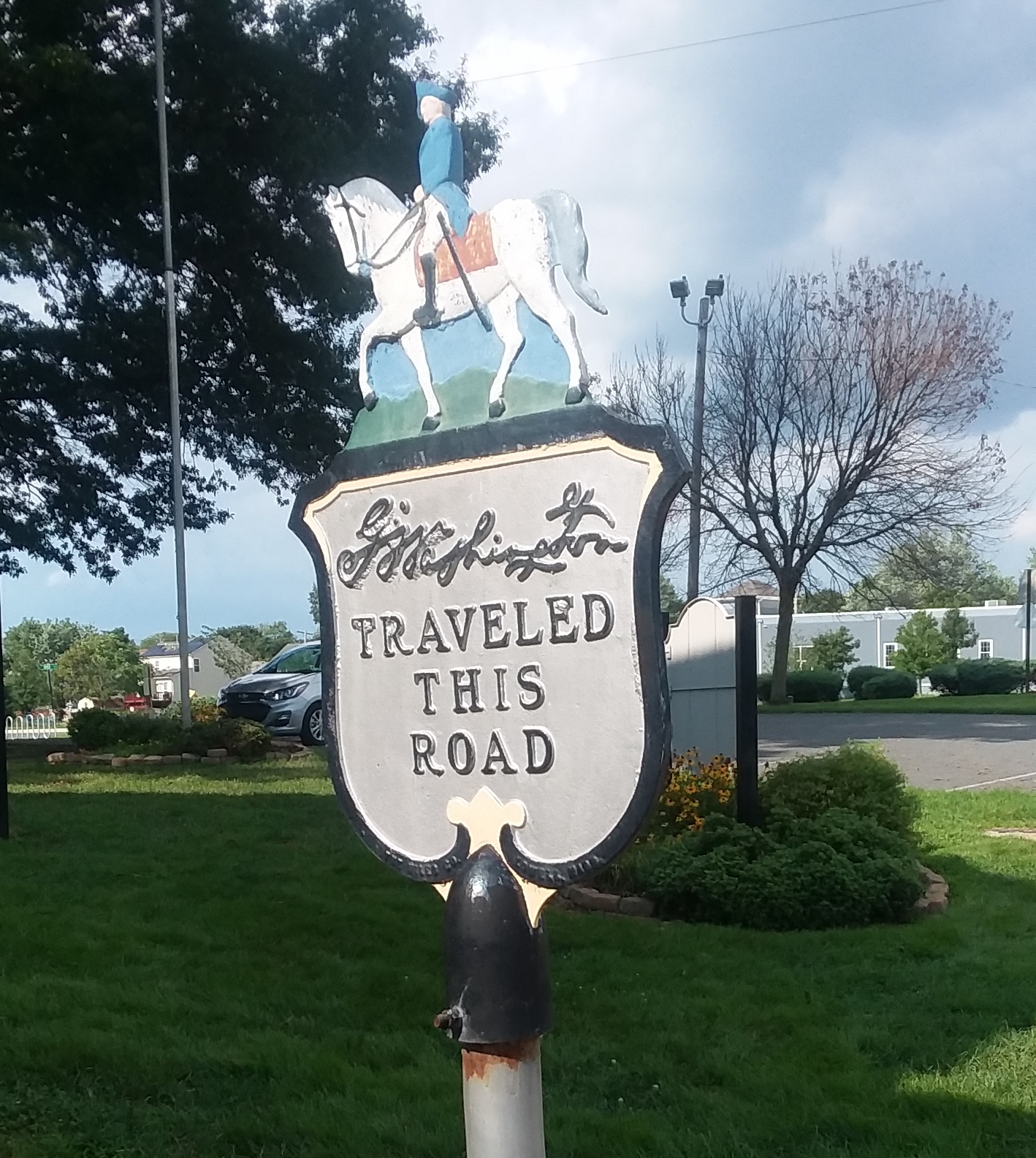
Sal continued down the Washington Highway
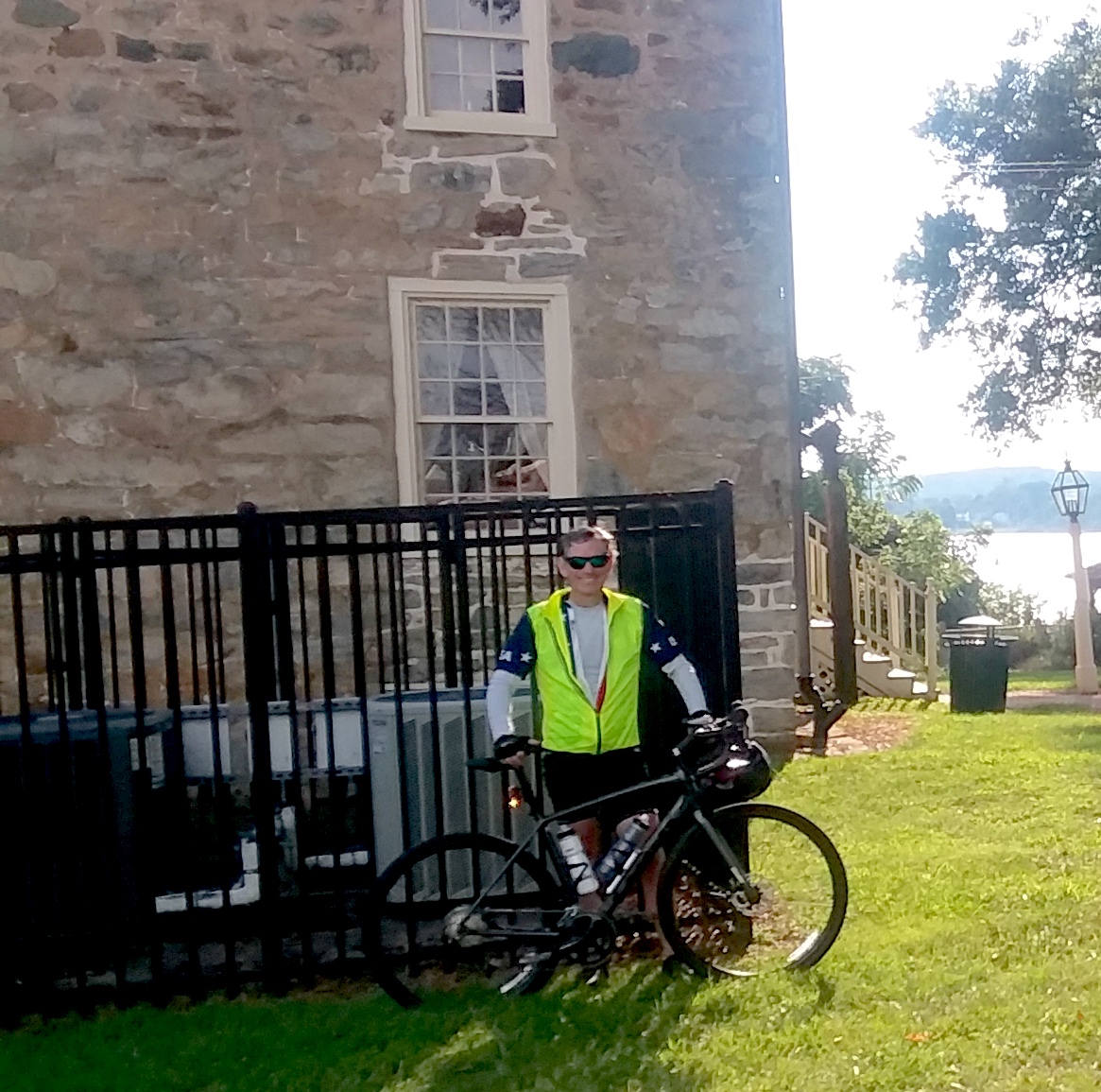
to Rodgers Tavern in Perryville, Maryland
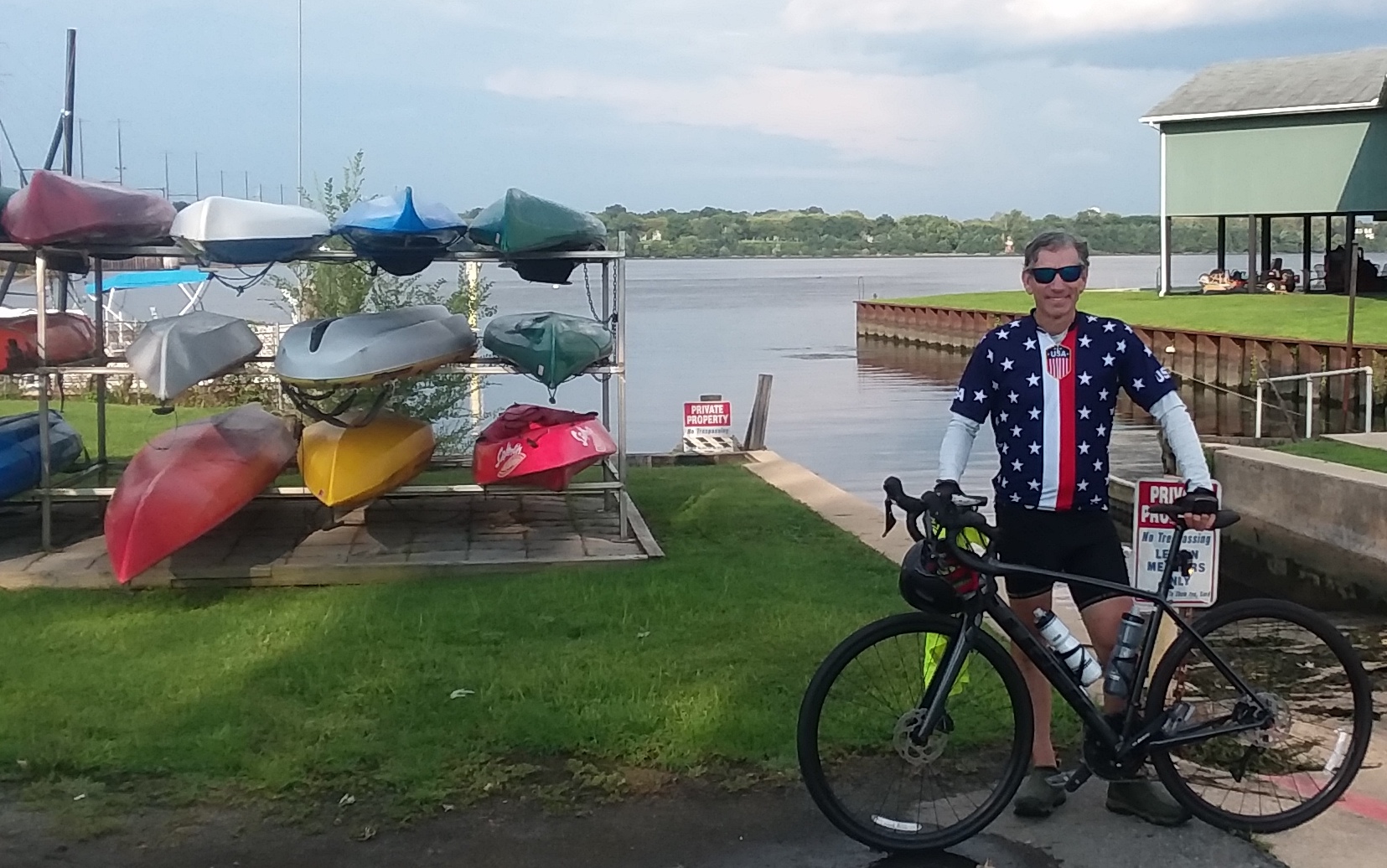
Without his own vessel, and it being too late in the day to rent one,
Sal had to forgo kayaking across the Susquehanna River from Perryville
to Havre de Grace, instead cycling across the U.S. Route 40 bridge
and pausing at a rack of vessels when he arrived.
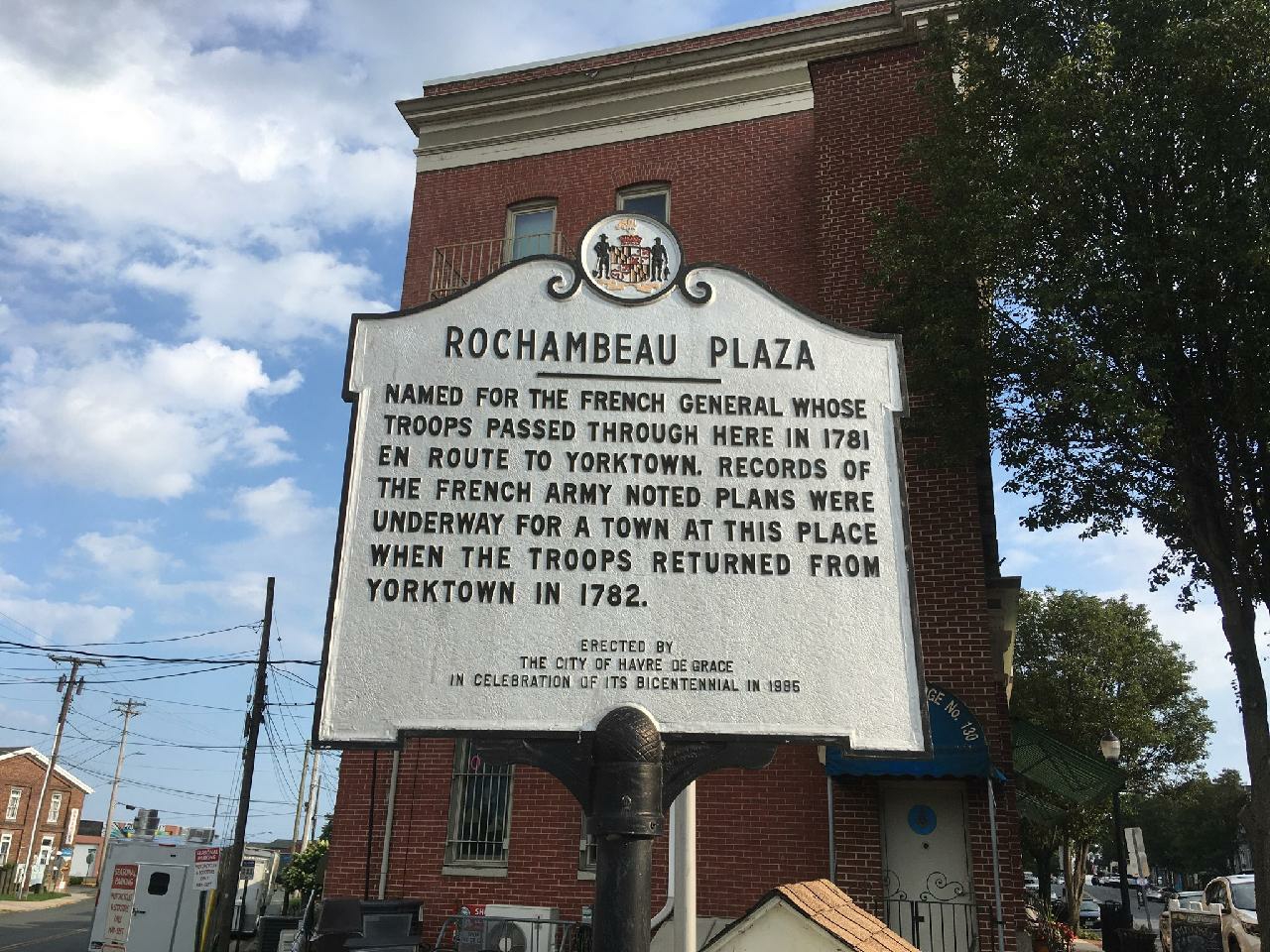
Havre de Grace has a plaza honoring Rochambeau
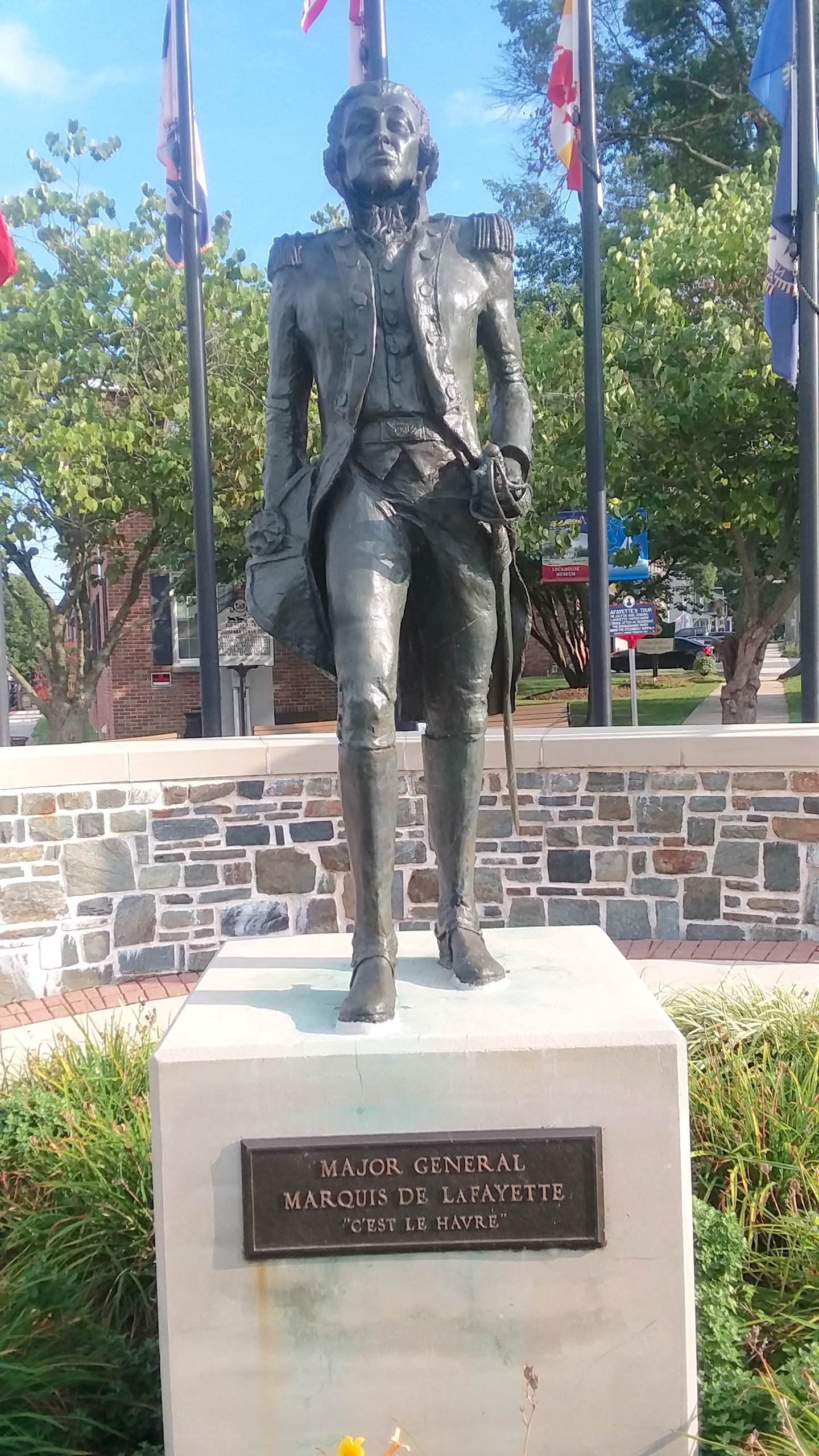
and another honoring Lafayette.
|
August 24 -- from Havre de Grace MD
This was a 39-mile bicycle pedal to Baltimore MD. |
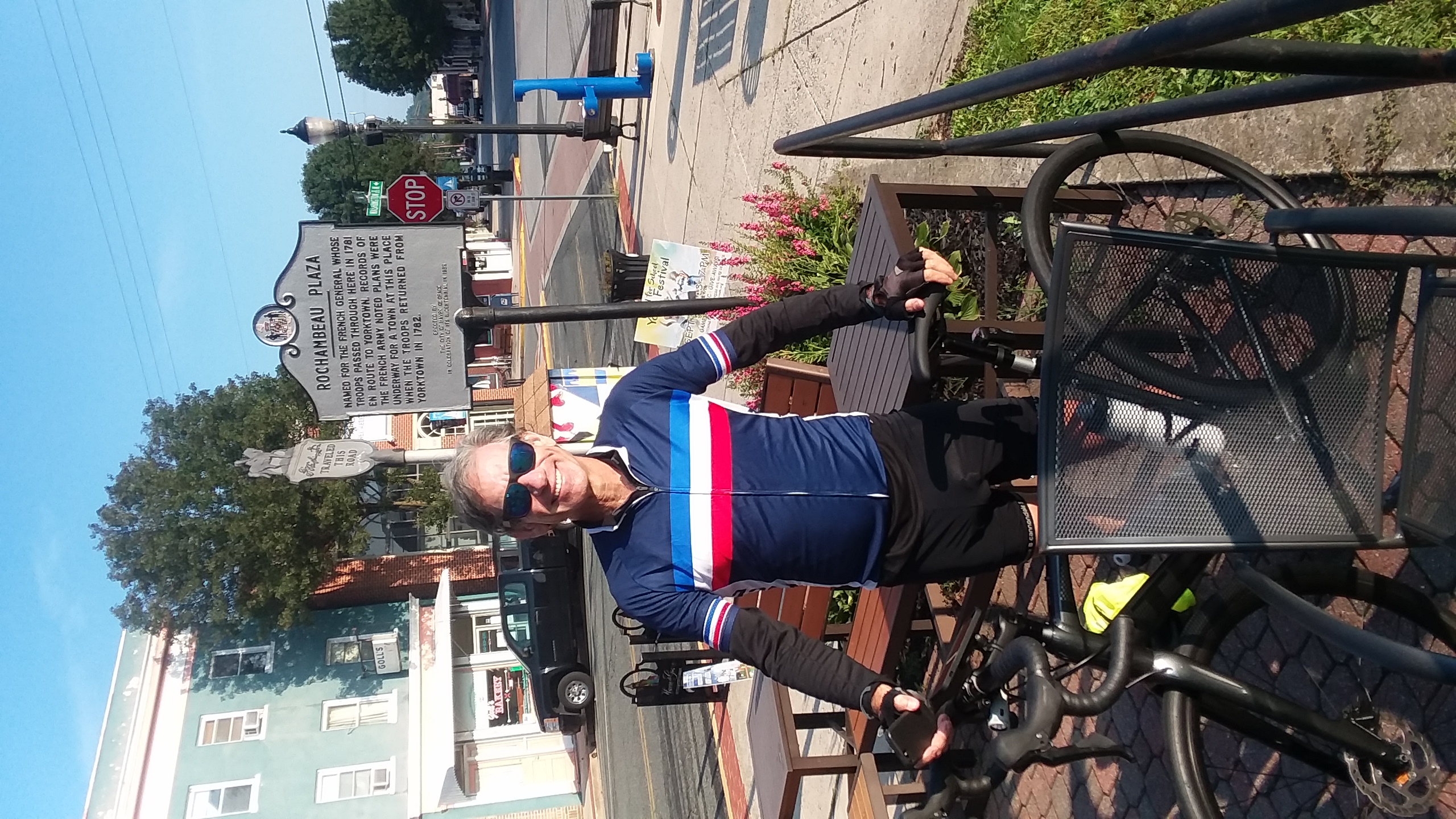
Sal returned to Rochambeau Plaza in Havre de Grace
for the start of today's 38-mile cycling segment.
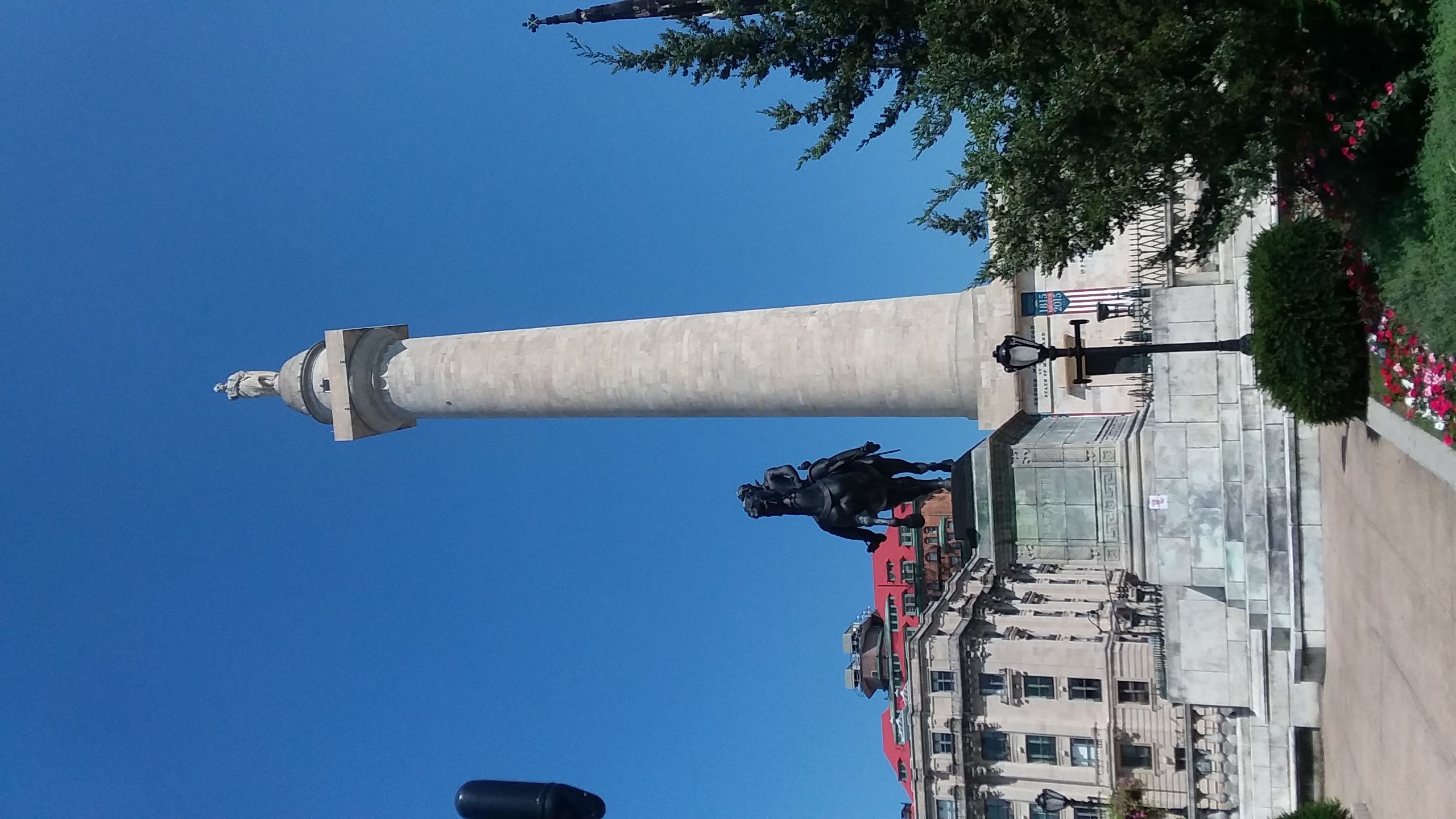
Lafayette (on horseback) and Washington (on the tall column)
are honored with monuments in Baltimore's Mount Vernon Cultural District
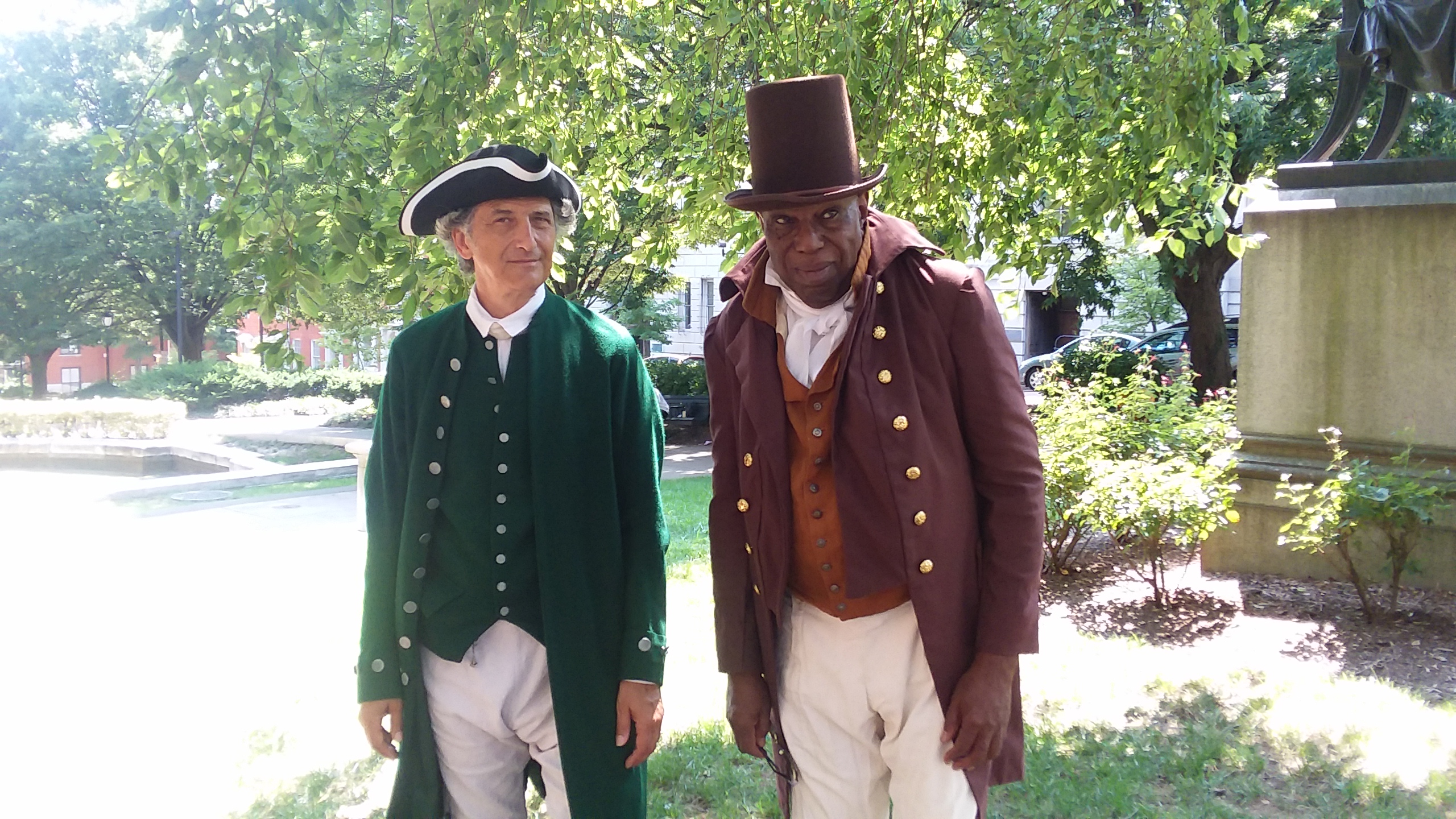
Participants in the noon program there included re-enactors Steven Lampredi
and Stephen Faulkner. See below for whom they were portraying .
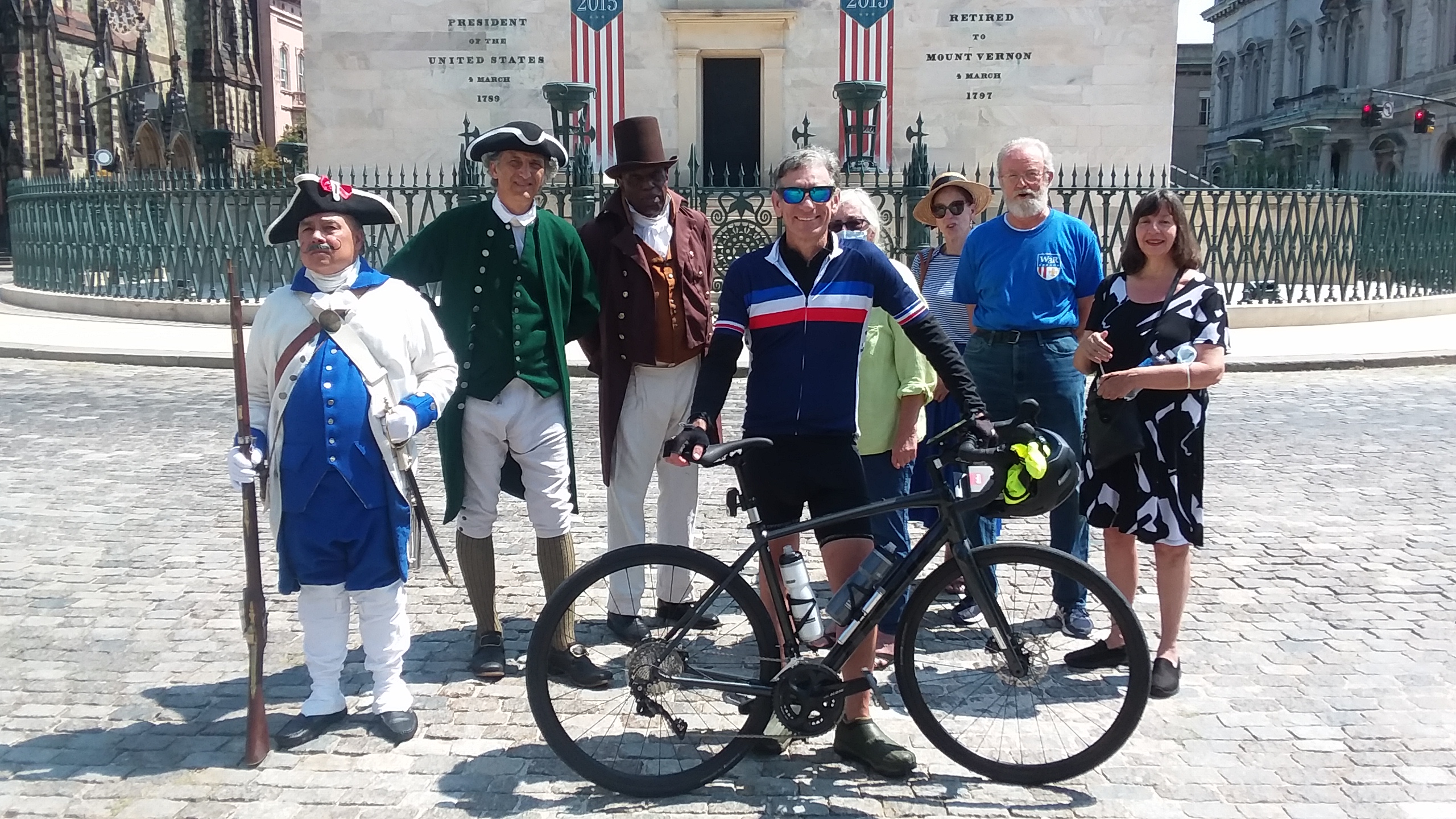
Participants gathered at the Washington Monument for a group shot.
|
Meet some of the men who helped win the American Revolution:
|
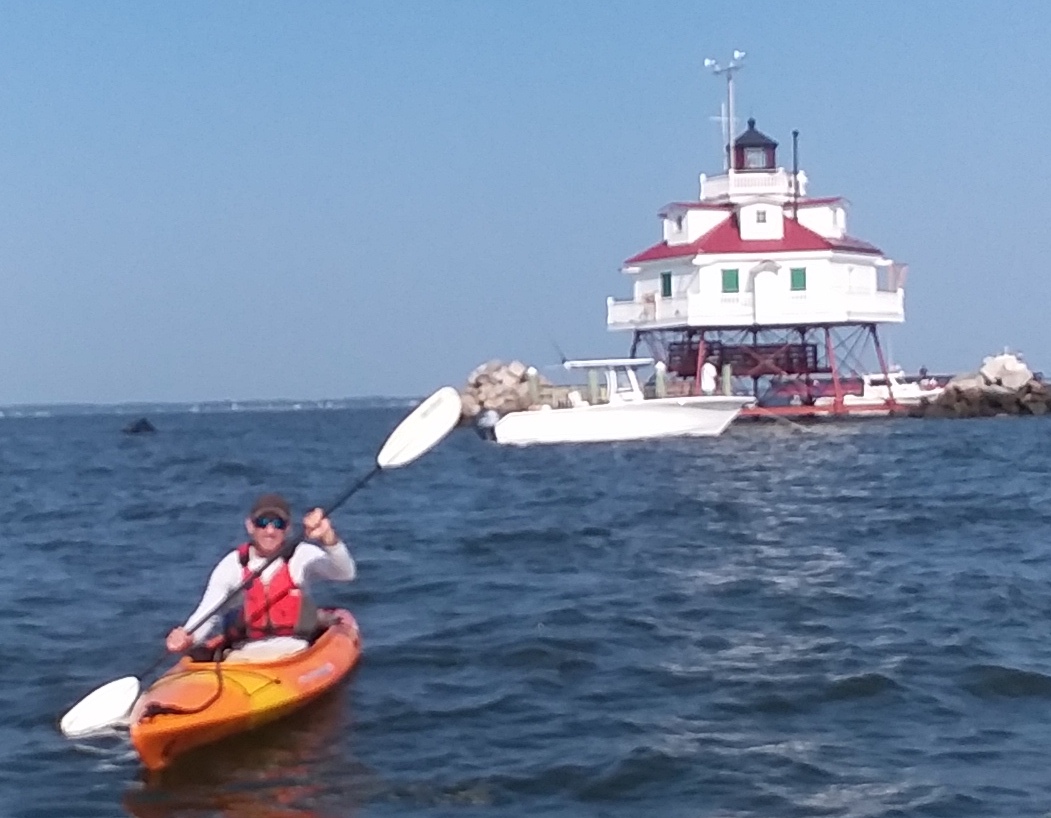
Jeff then drove Sal to Annapolis, where Sal's cousin Larry Nordhauser loaned him his kayak
and took him to the Thomas Point Shoal Lighthouse for kayaking in Chesapeake Bay
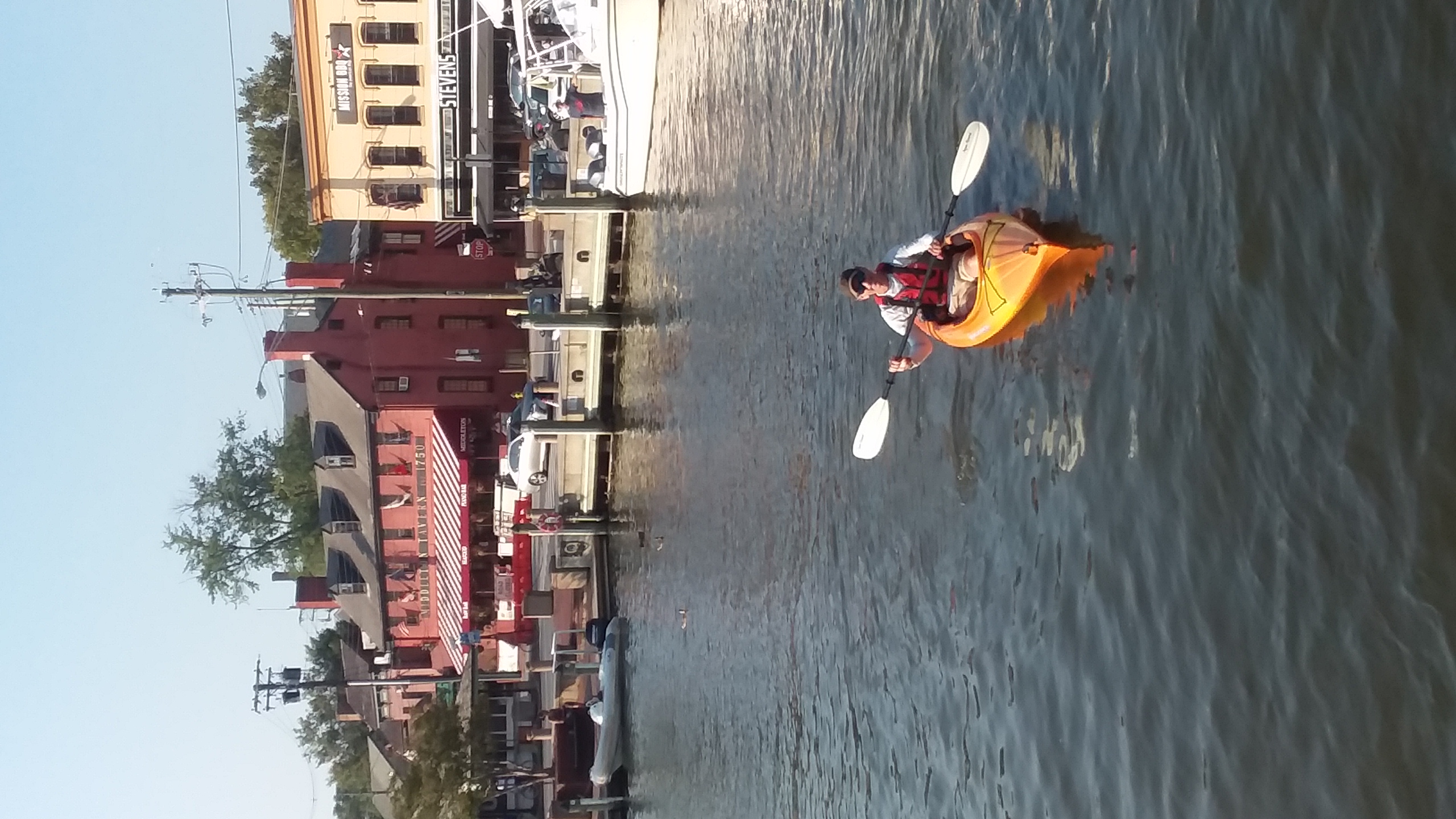
Final stop was kayaking near Annapolis' city dock.
We return to Baltimore tomorrow to cycle to Annapolis
for a 1 PM ceremony at the State House.
|
August 25 -- from Baltimore MD
Jeff drove Sal back to Baltimore to start today's 38-mile cycling trek at the Washington Monument. |
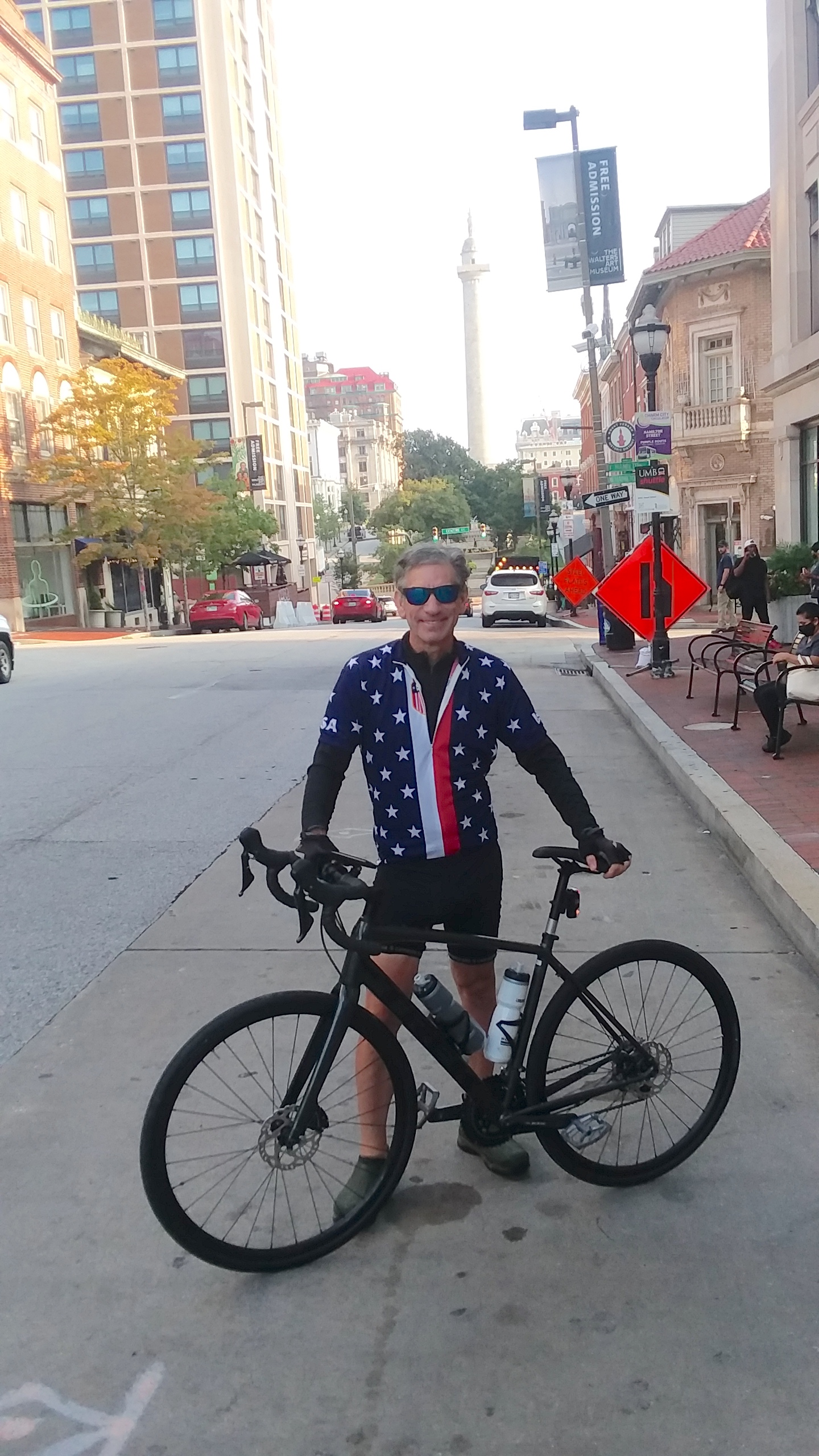
Monument in the mist at back
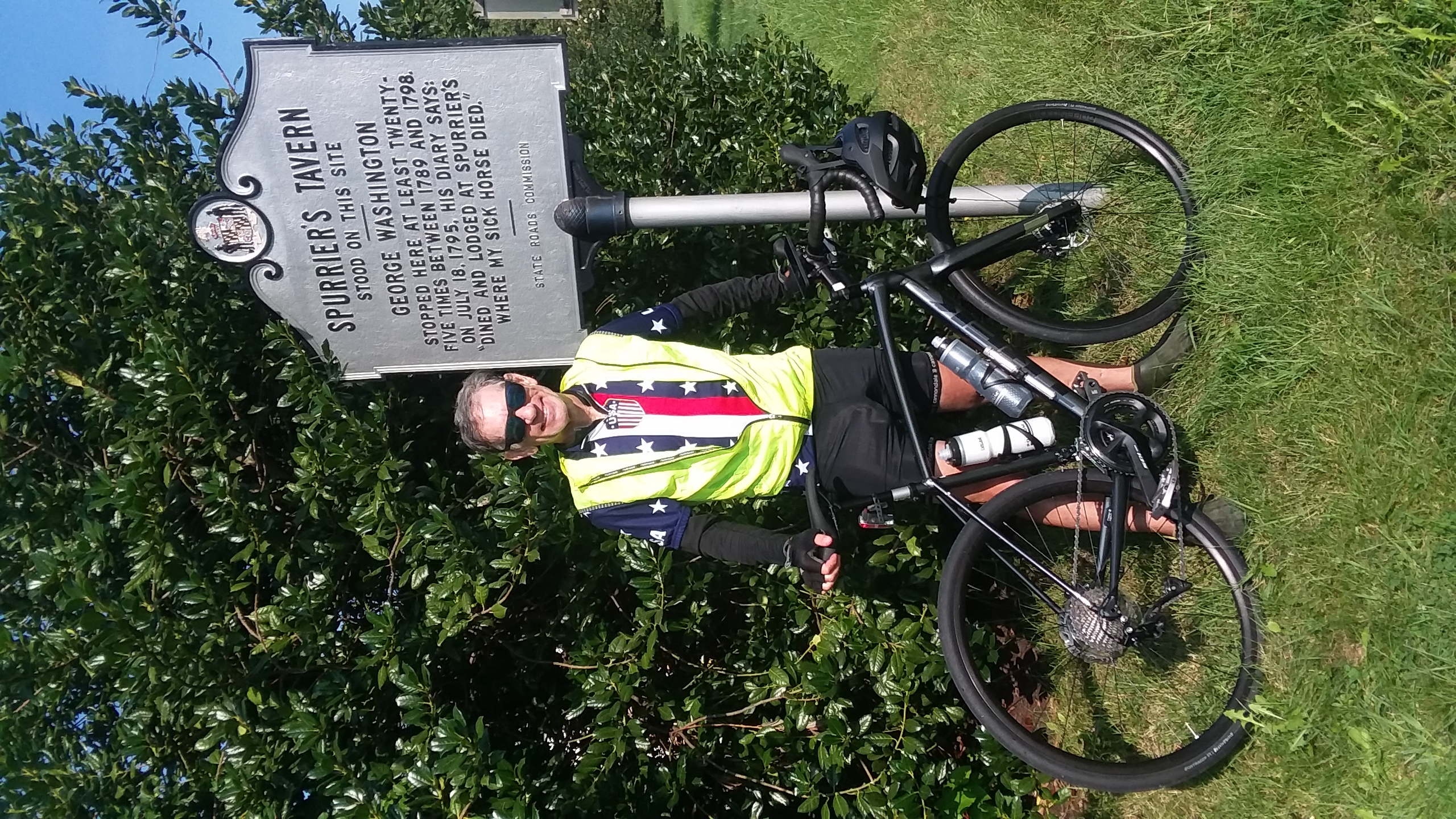
Following the Old Post Road (now Generals Highway) to the State House in Annapolis,
Jeff photographed three markers at sites significant to Washington and Rochambeau.
Spurrier's Tavern (above)
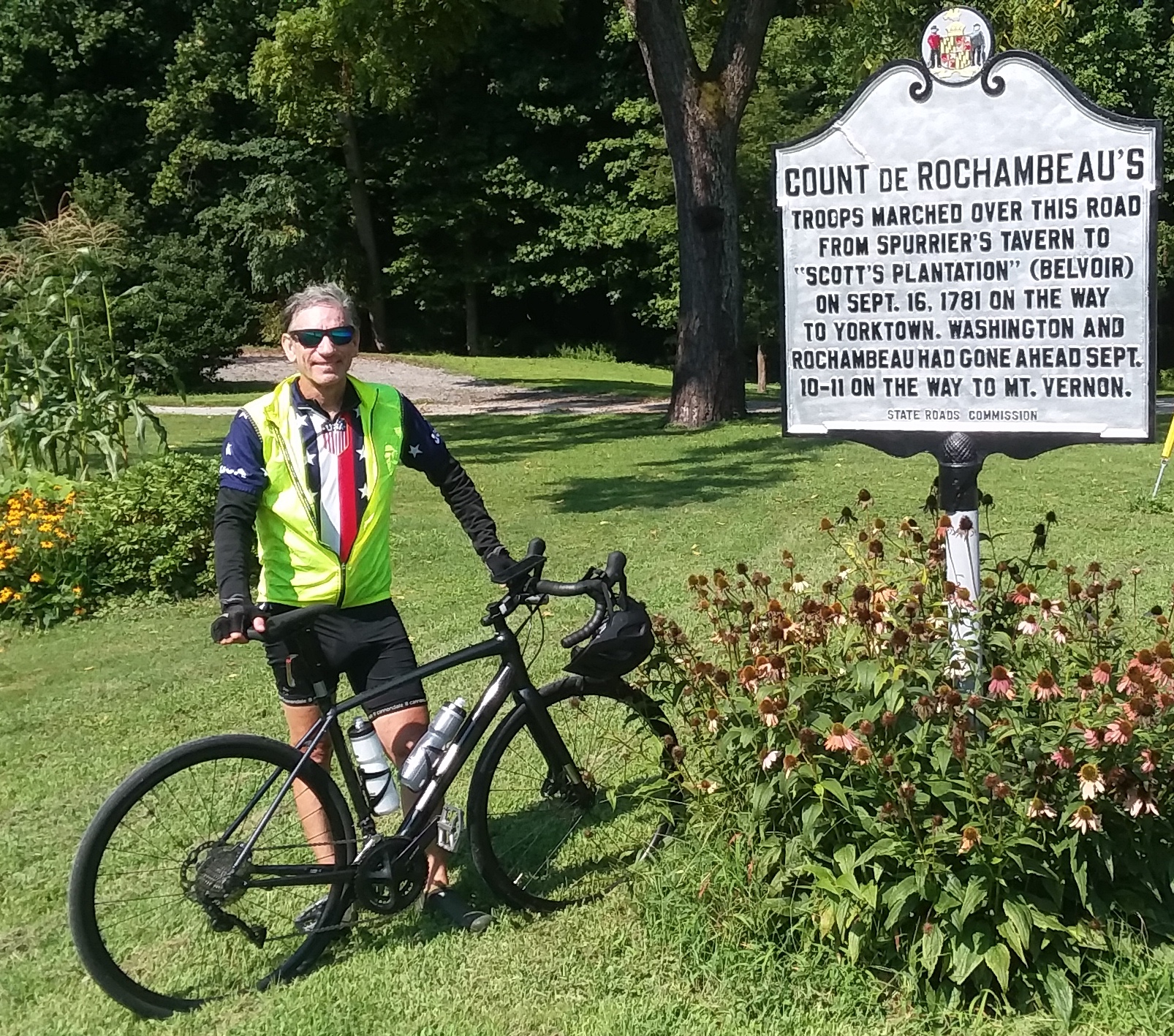
The road through Crownsville
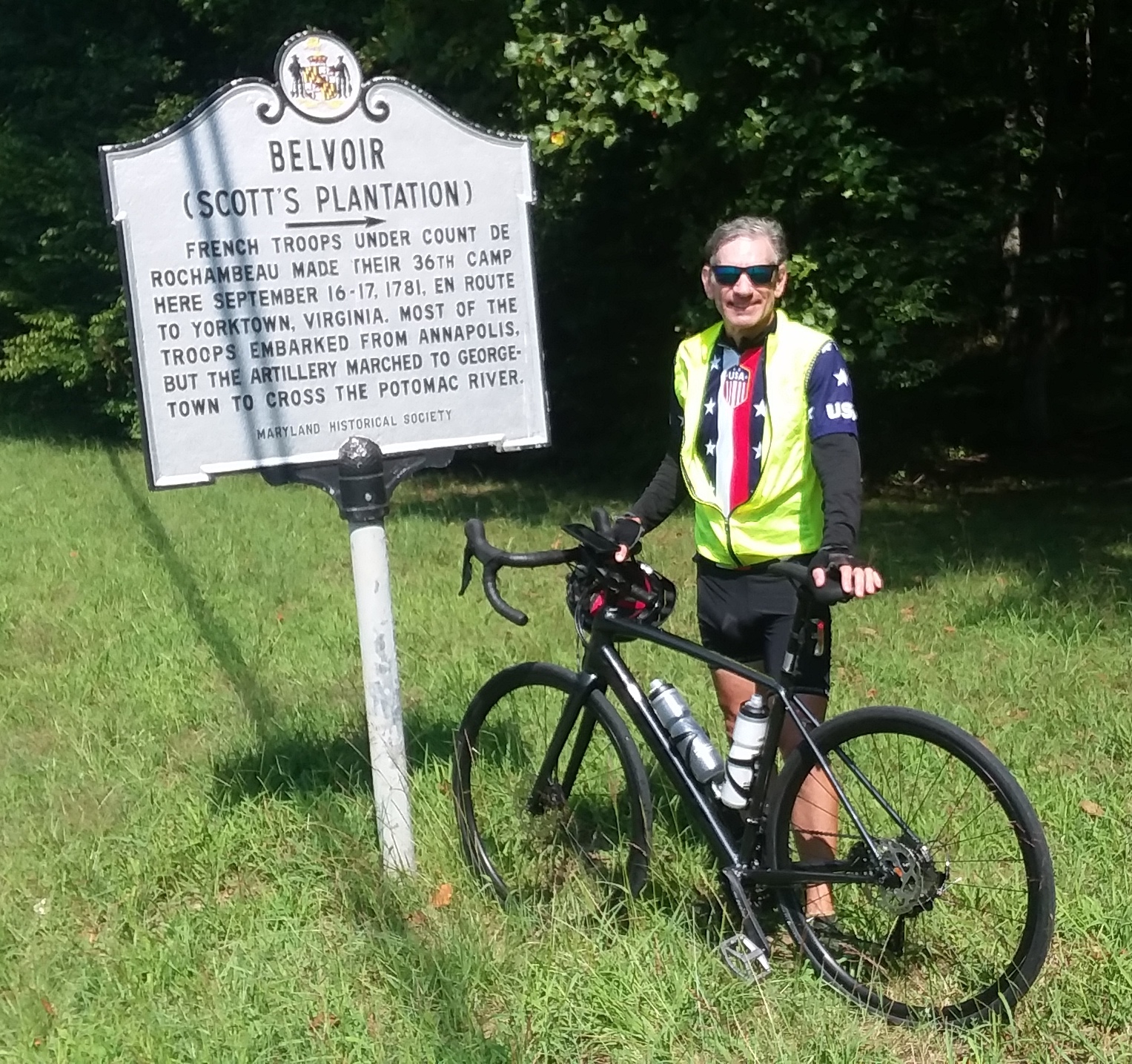
and Belvoir
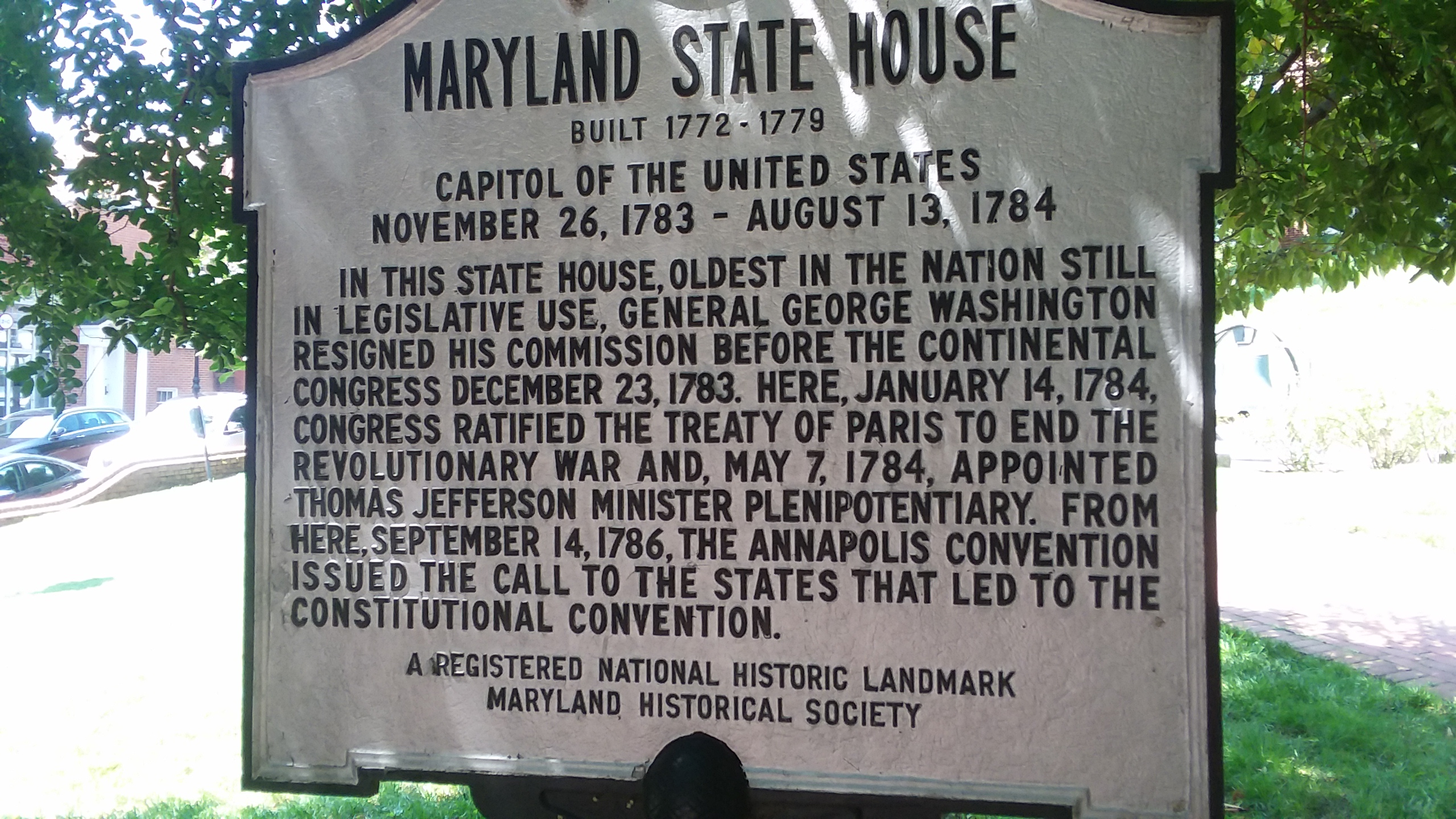
The Maryland State House, built in 1772, has seen a lot of history significant
to the life of the young United States. Here in 1773 Washington followed the example
of the Roman general Cincinnatus, who -- after saving the republic --
resigned his commission and returned to civilian life
rather than become a dictator (or king).
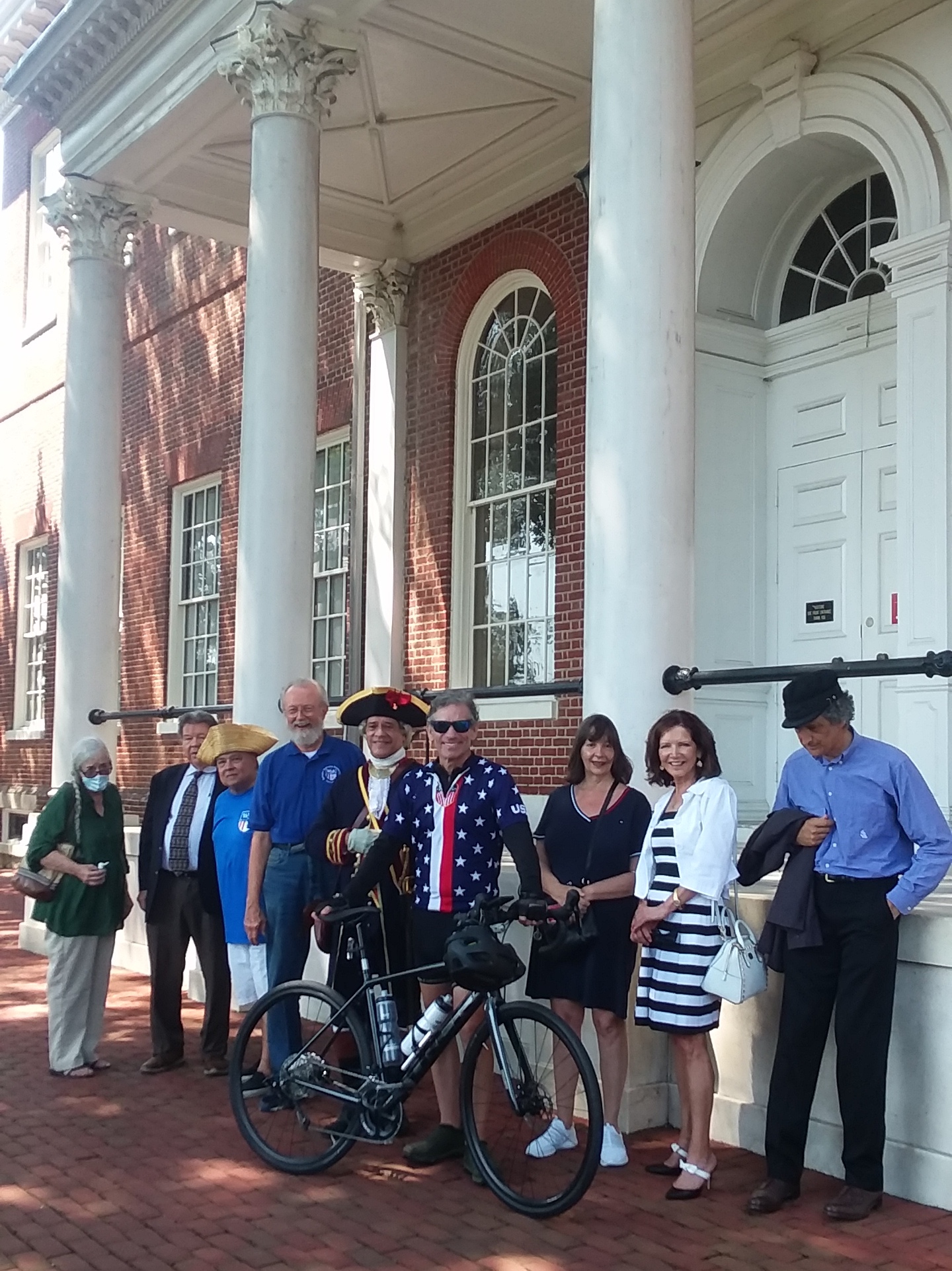
Sal and Jeff with the welcoming group of W3R®-US officers
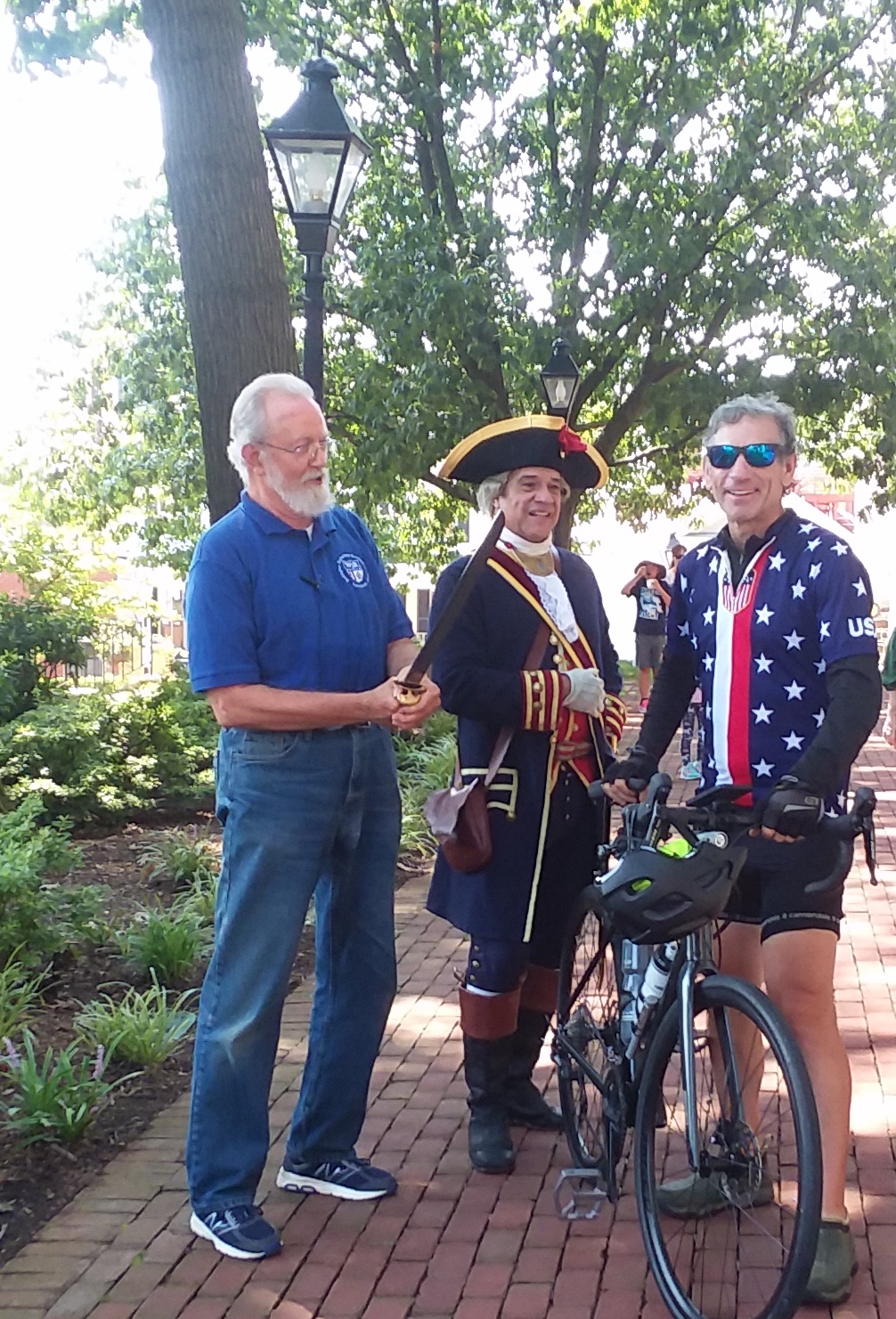
Hector L. Diaz (center), portrays General Bernardo de Galvez,
who commanded Spanish forces in the Louisiana territory
(much larger than the present state). Those forces, with French aid,
captured the fortified port of Pensacola in May 1781. Jeff holds Hector's sword.
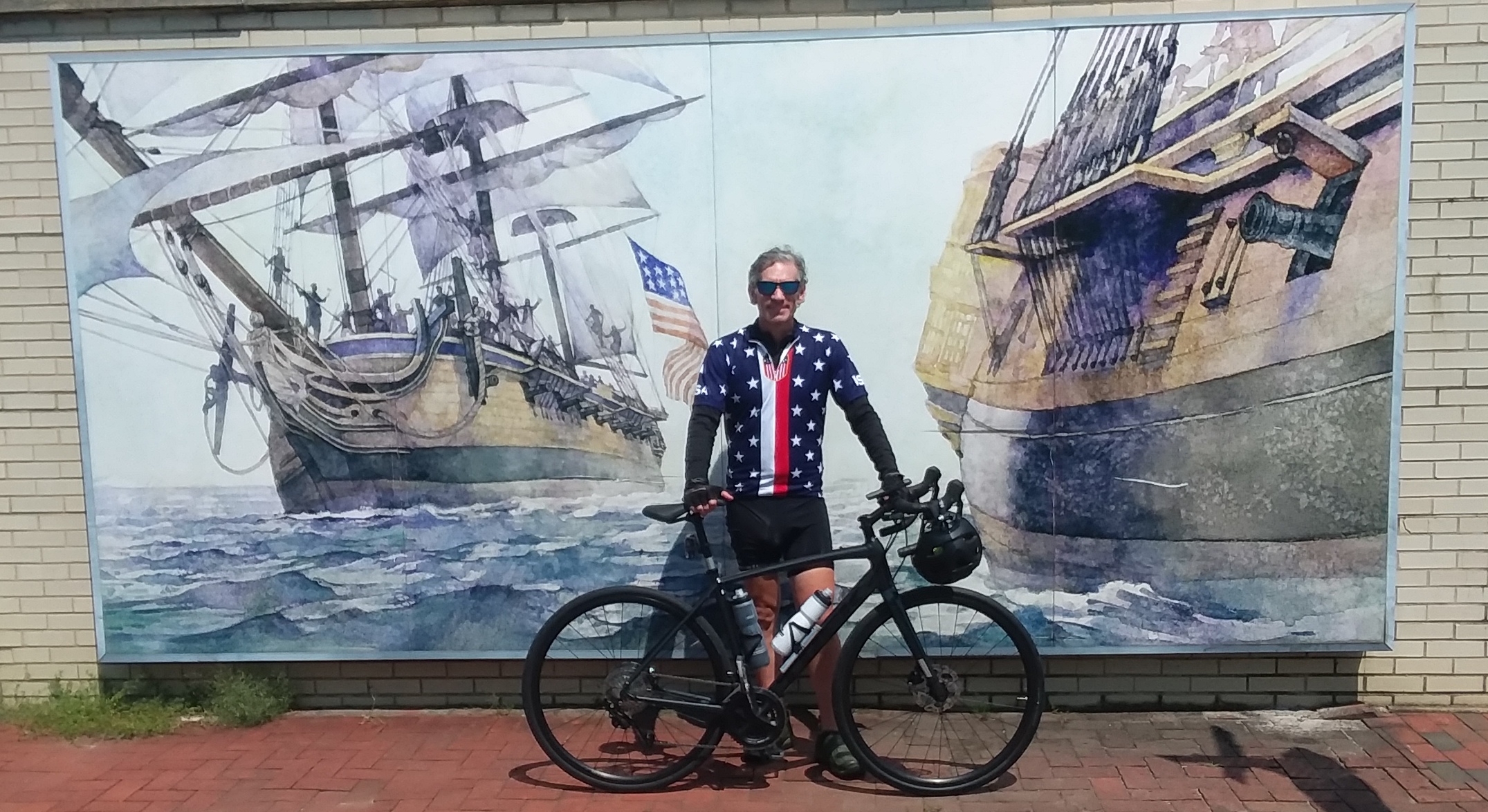
Sal's route went past a mural near an entrance to the U.S. Naval Academy.
This depicts then-Captain John Paul Jones' (on the French-donated) 42-gun ship
Bon Homme RIchard capturing the 55-gun British ship Serapis in September, 1779.
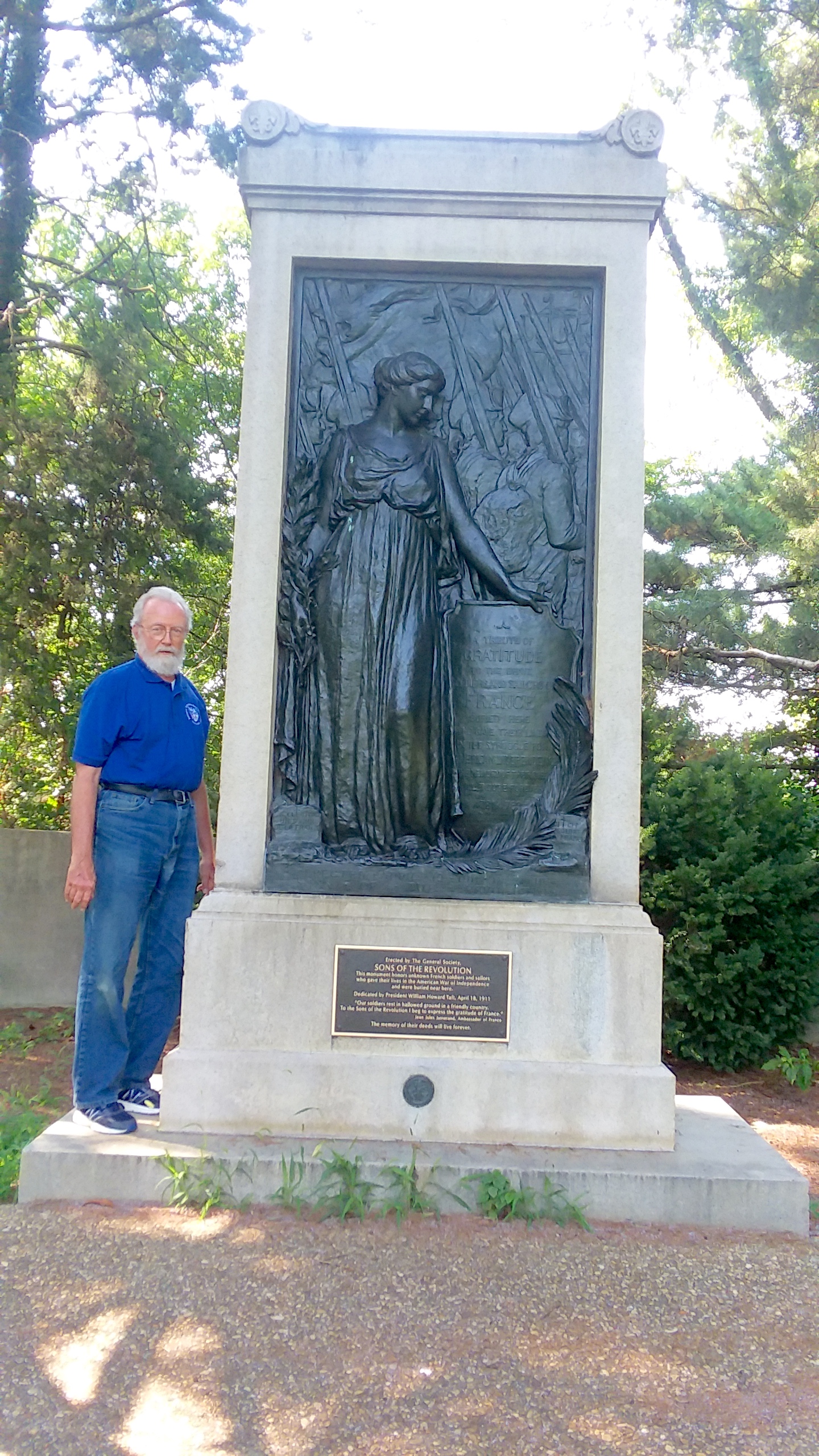
After lunch at the Middleton Tavern, Jeff paid his respects to a 1911 monument
on the campus of Saint John's College. This honored the French soldiers and sailors
who helped the United States win its independence.
| August 26 -- from Annapolis MD |
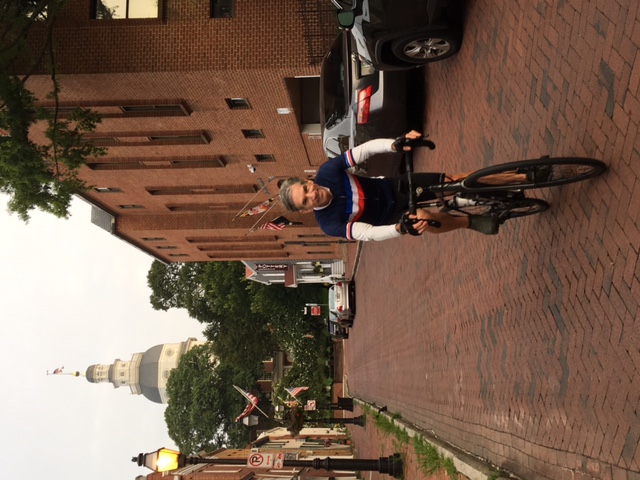
Sal began today's 69-mile segment at the State House in Annapolis MD.
He retraced the route back to U.S. Route 1, then headed south
to Washington DC. The preferred route was blocked by congestion,
construction and a heavy police presence.
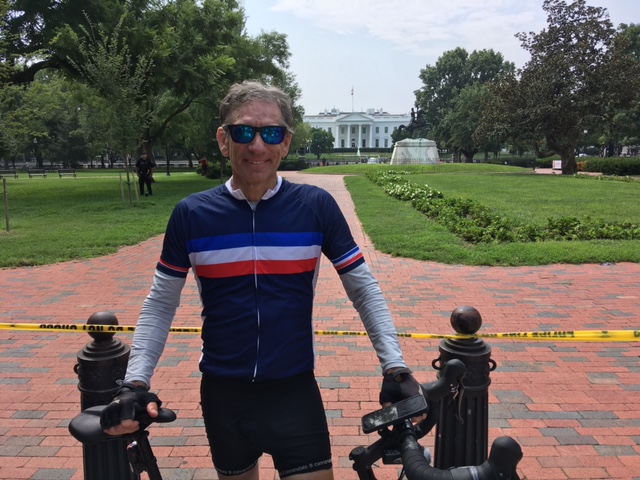
Sal finally got to Lafayette Park, opposite the White House.
Here is Sal with the White House and a statue of Rochambeau erected in 1902.
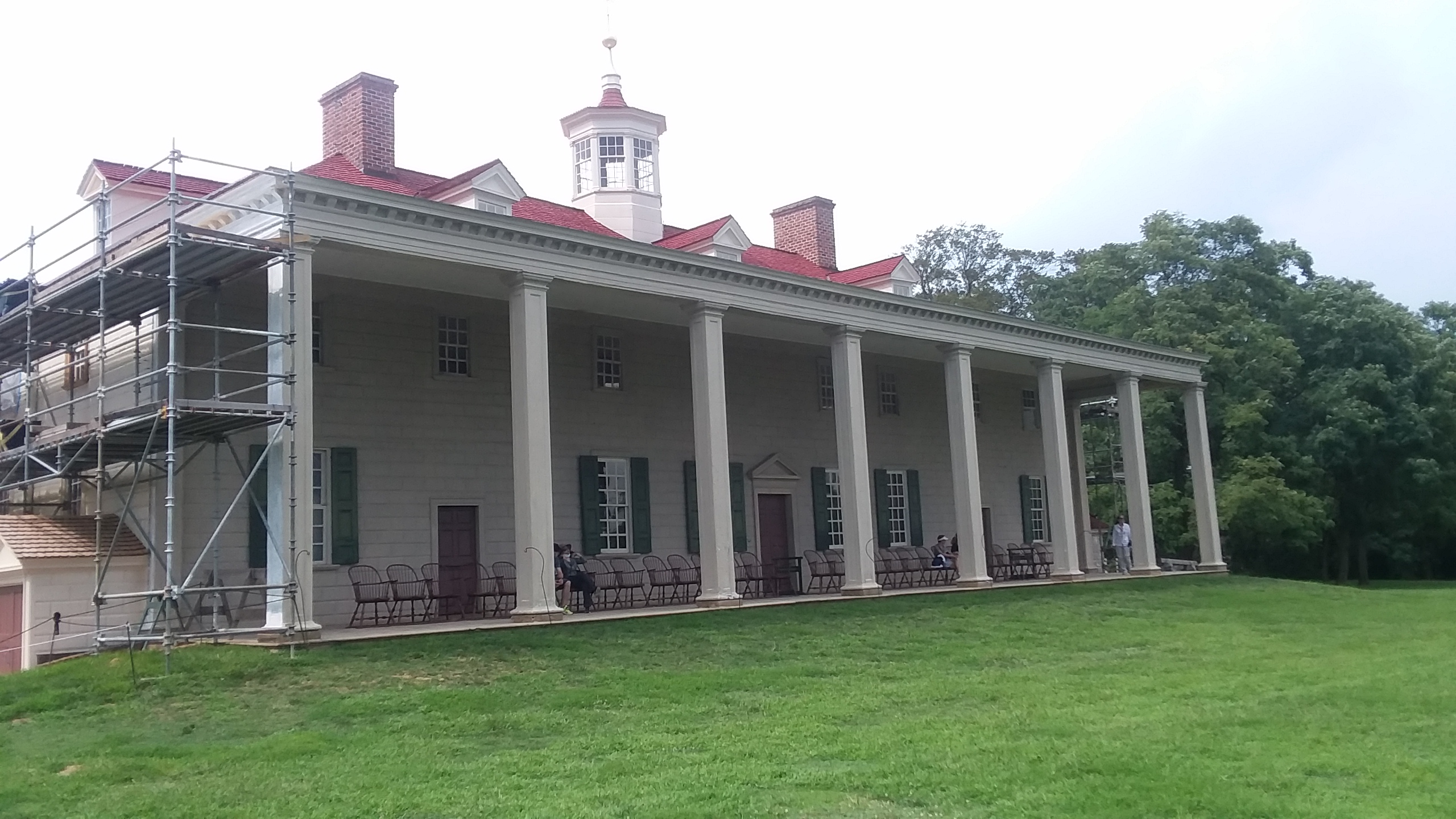
The next stop was George Washington's Mount Vernon, in Virginia.
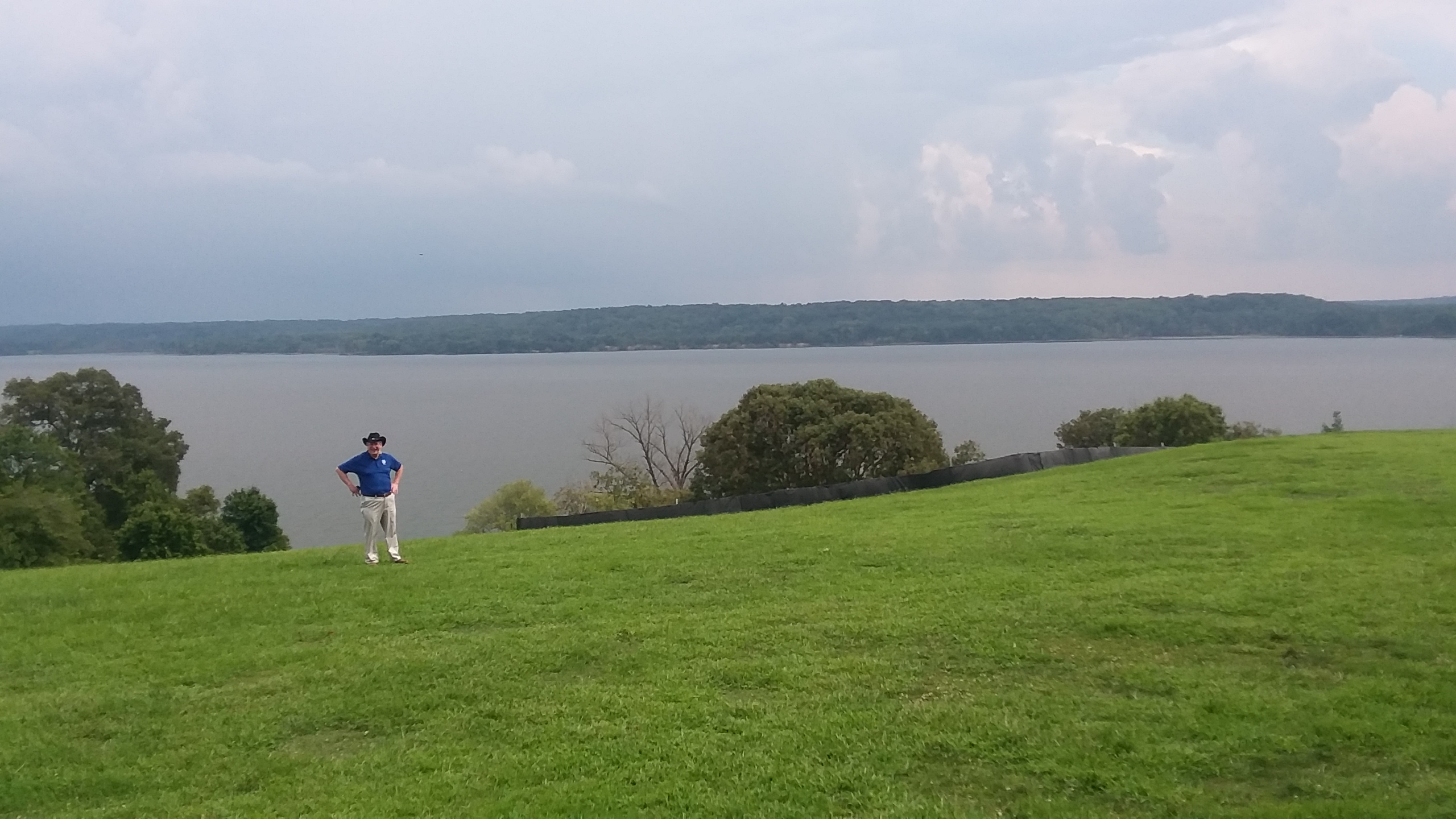
The view of the Potomac River from Mount Vernon was as magnificent as advertised.
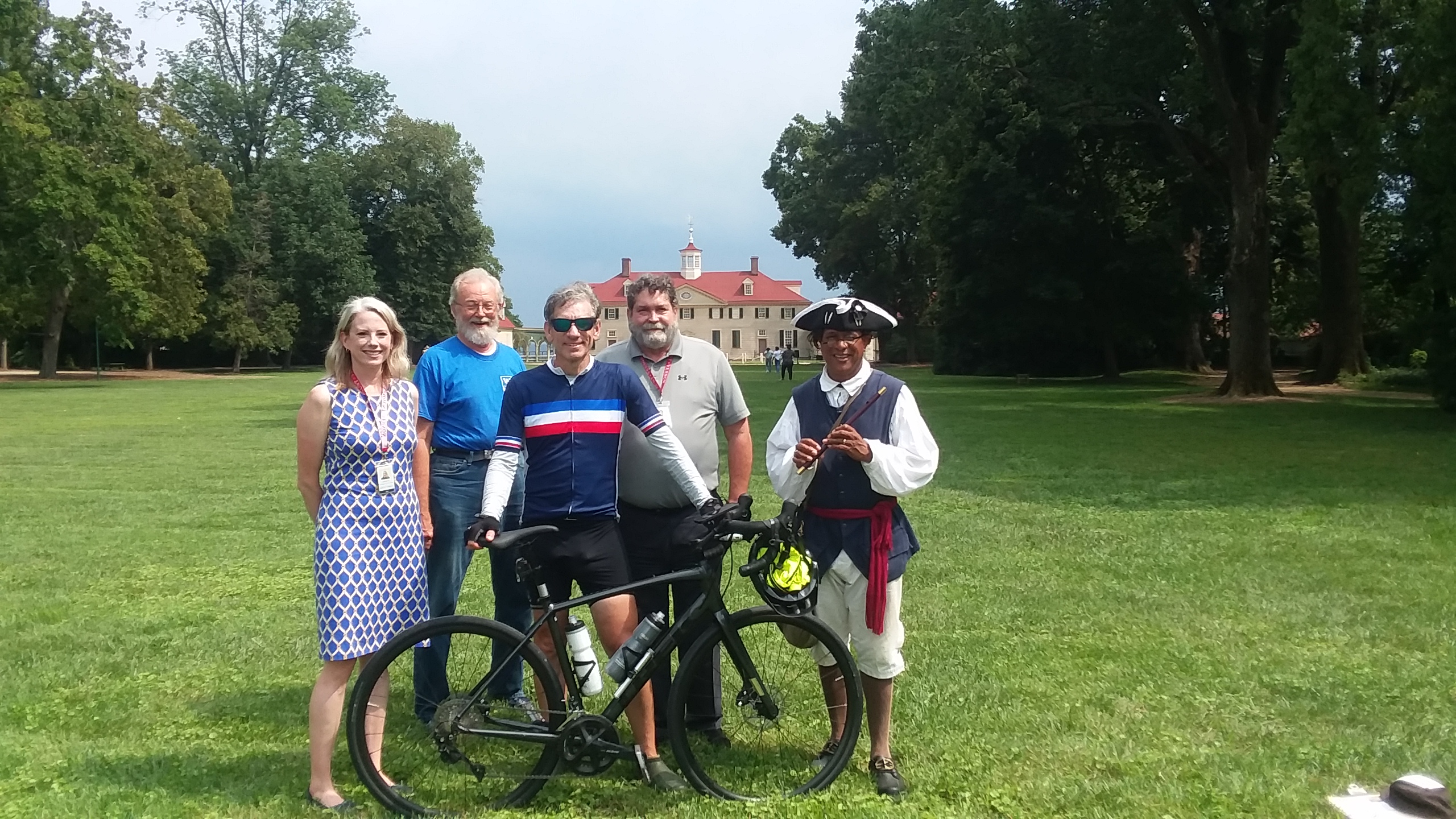
Sal had special permission to bring in his bike (usually not allowed).
Thanks to W3R®-US Treasurer Dave Meredith
and W3R®-US Director Sam Meredith for making the arrangements.
A thoughtful commentary on the two days during which Rochambeau
and his staff were hosted at Mount Vernon by Washington
was written by Durf McJoynt. See Two Days at Mount Vernon.
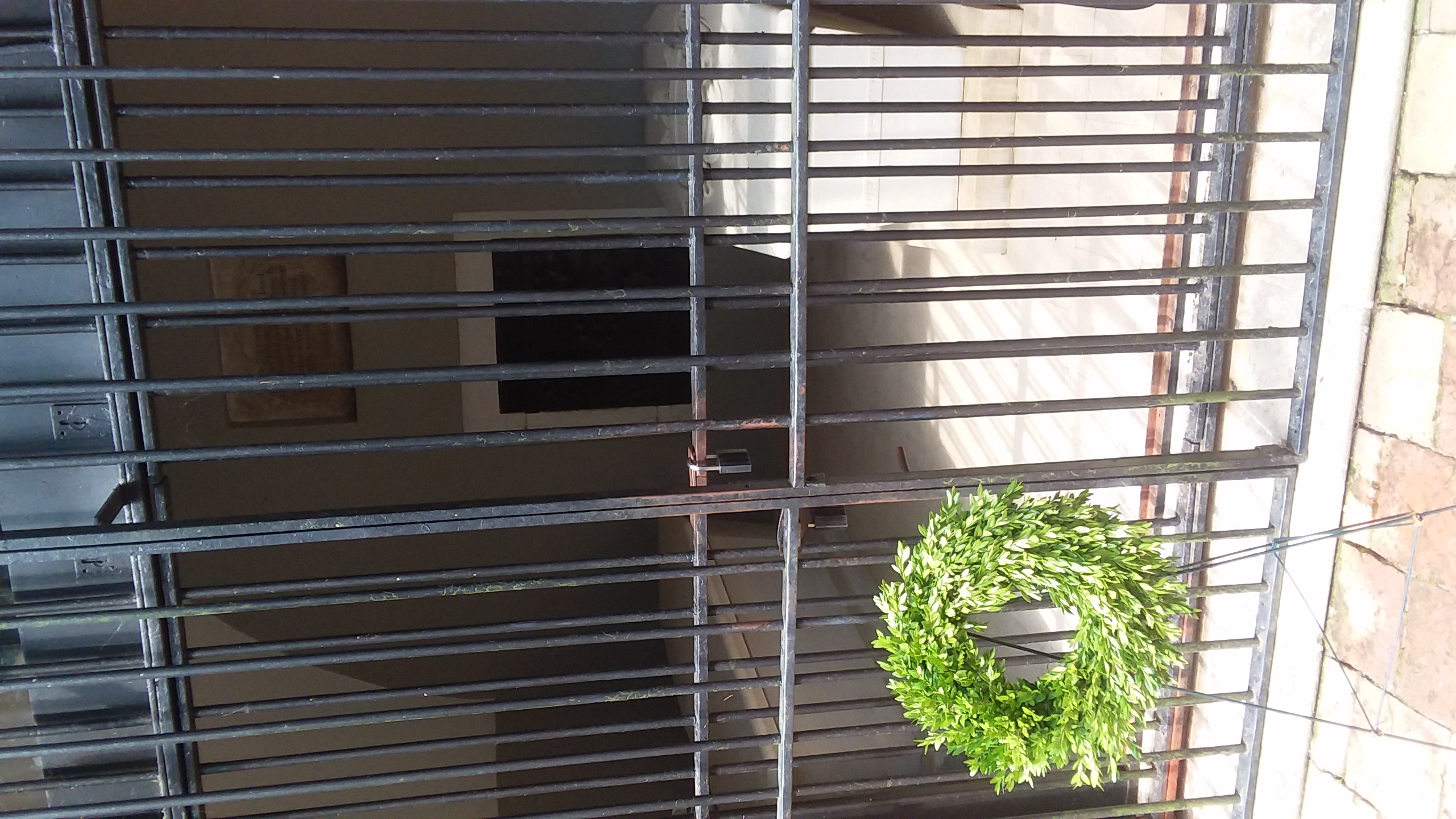
George and Martha Washington are buried on the grounds in a vault
that contains some two dozen other family members.
W3R®-US Corresponding Secretary Elaine Lawton hosted
a dinner for Sal, Jeff, and W3R®-US Chair Larry Abell.
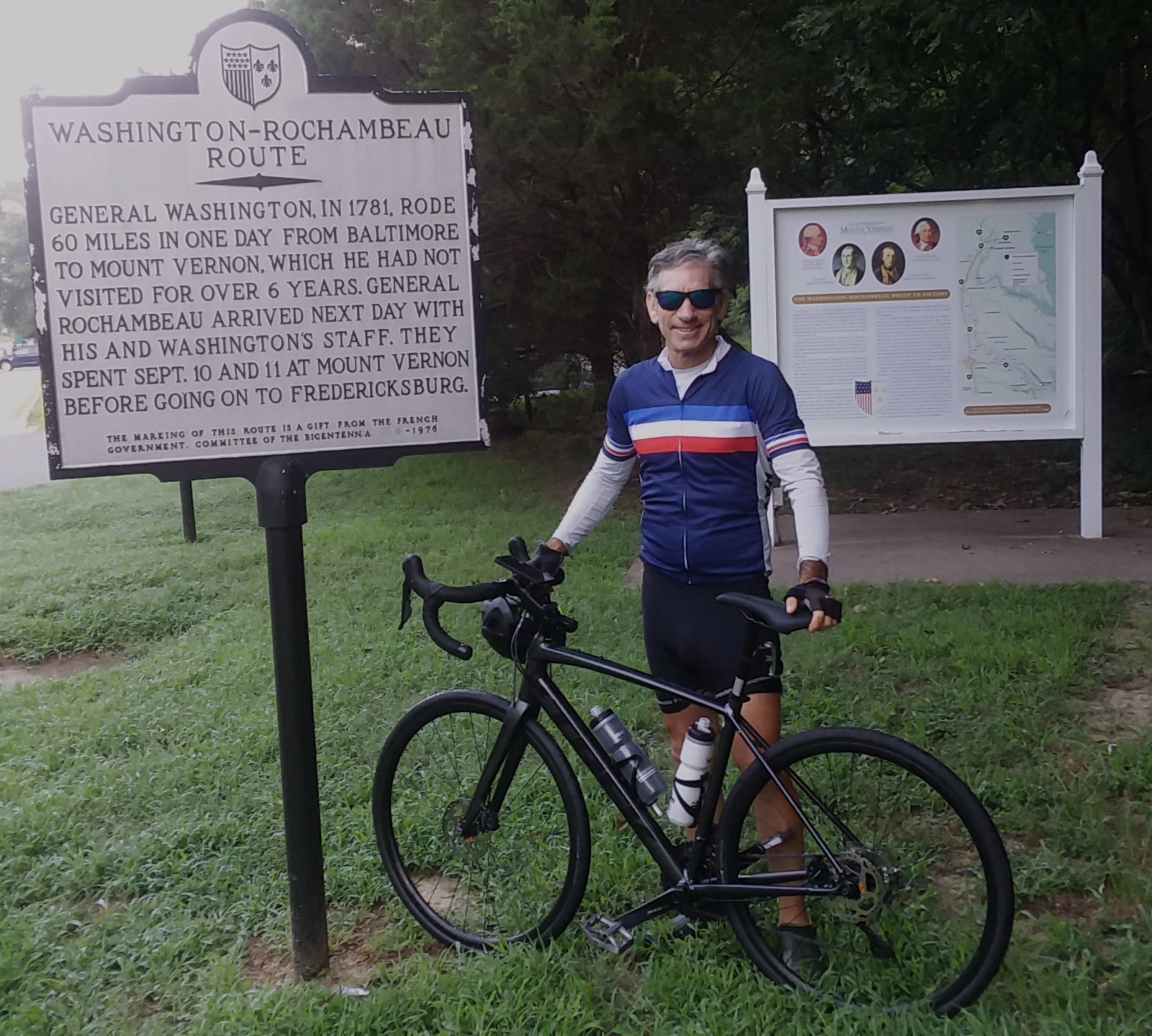
Sal was on his way a little after 7 AM. Note that the interpretive sign
was donated by France in 1976 for the bicentennial commemoration.
The background sign was placed more recently by the DAR.
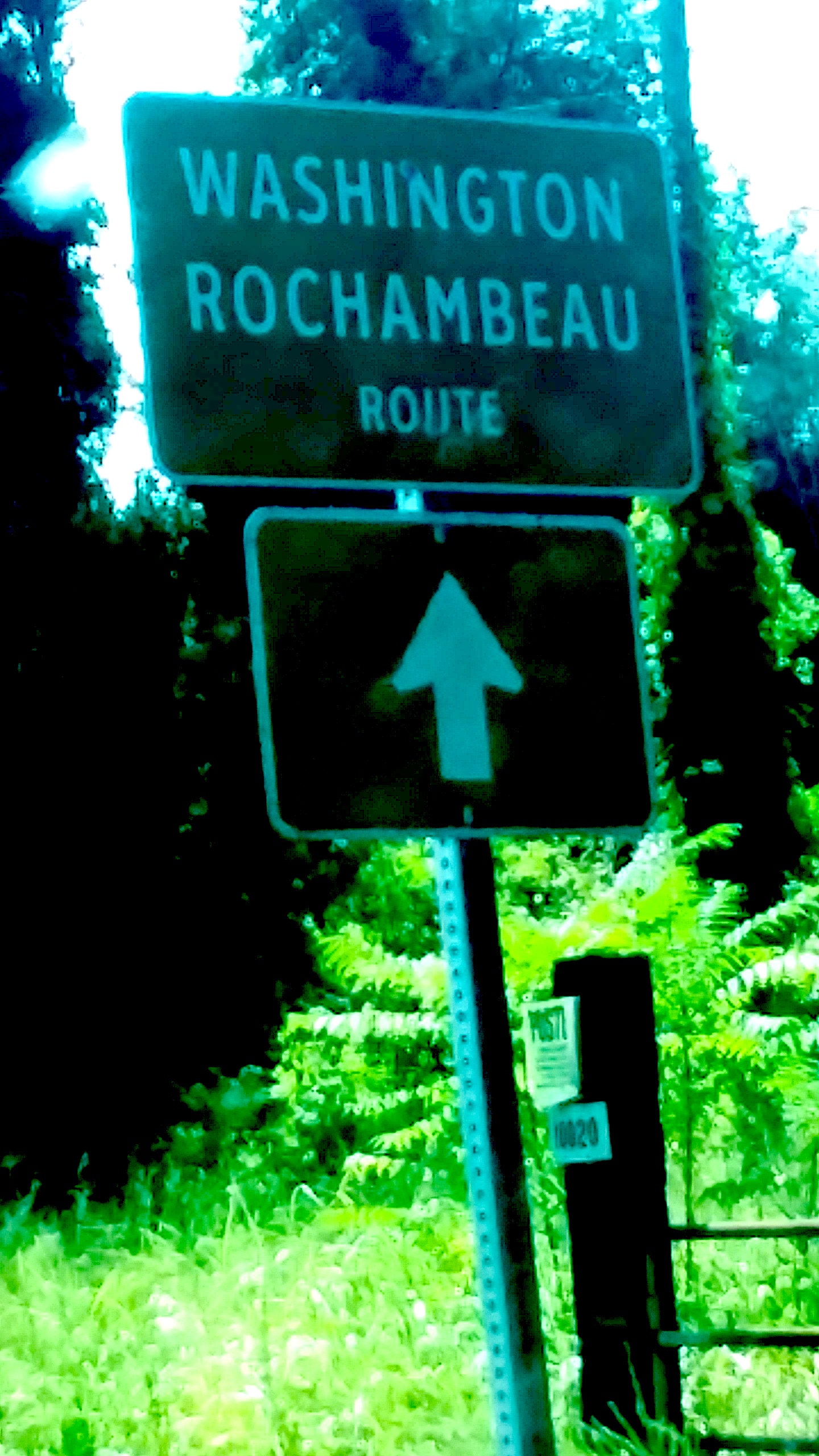
He followed U.S. Route 1 to Fredericksburg VA, then turned slightly southeast to U.S. 17,
Virginia 2 and U.S. 301, which were marked by "Washington Rochambeau Route" signs.
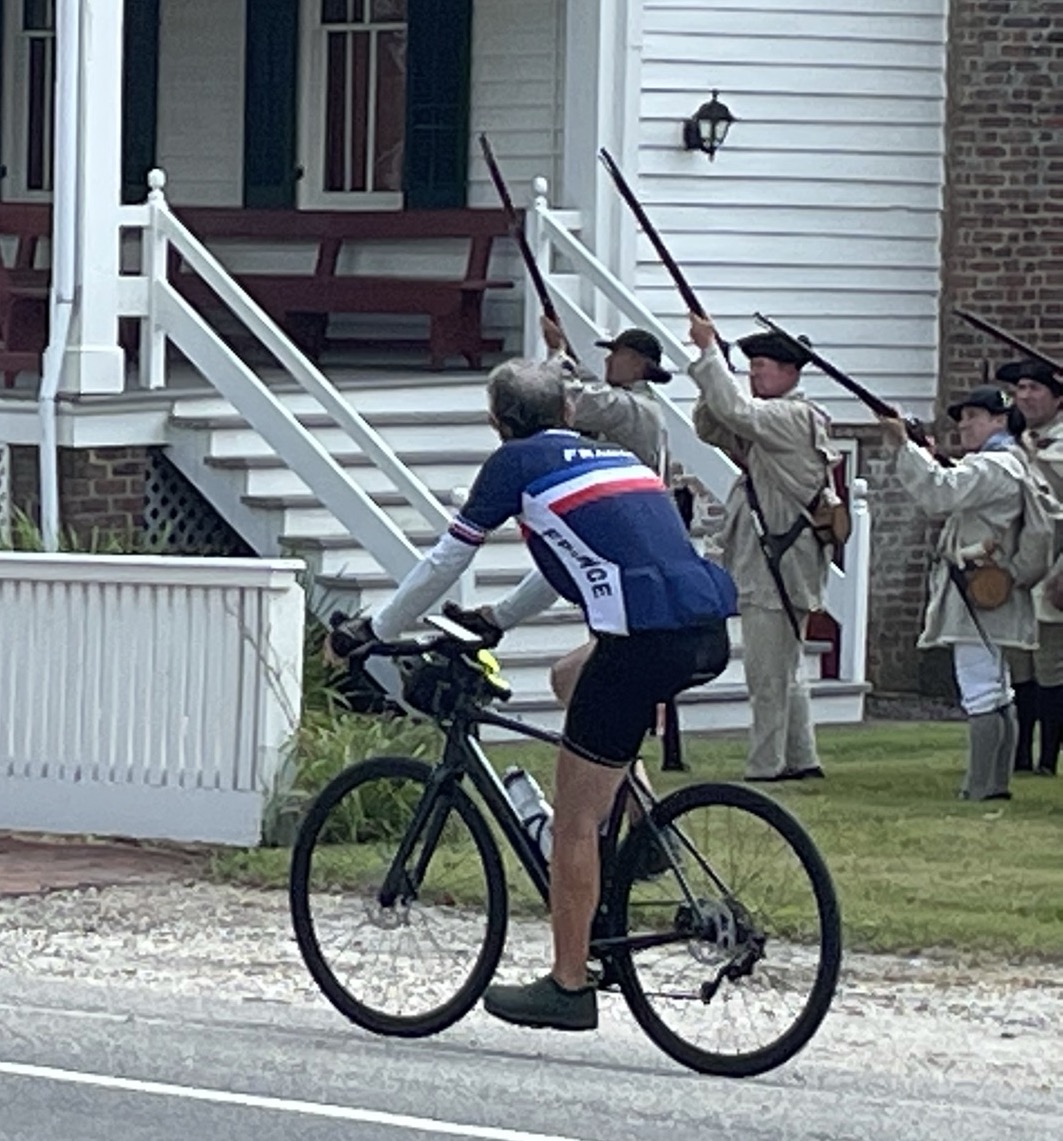
Sal rolled into Hanover (just northeast of Richmond) at 3 PM.
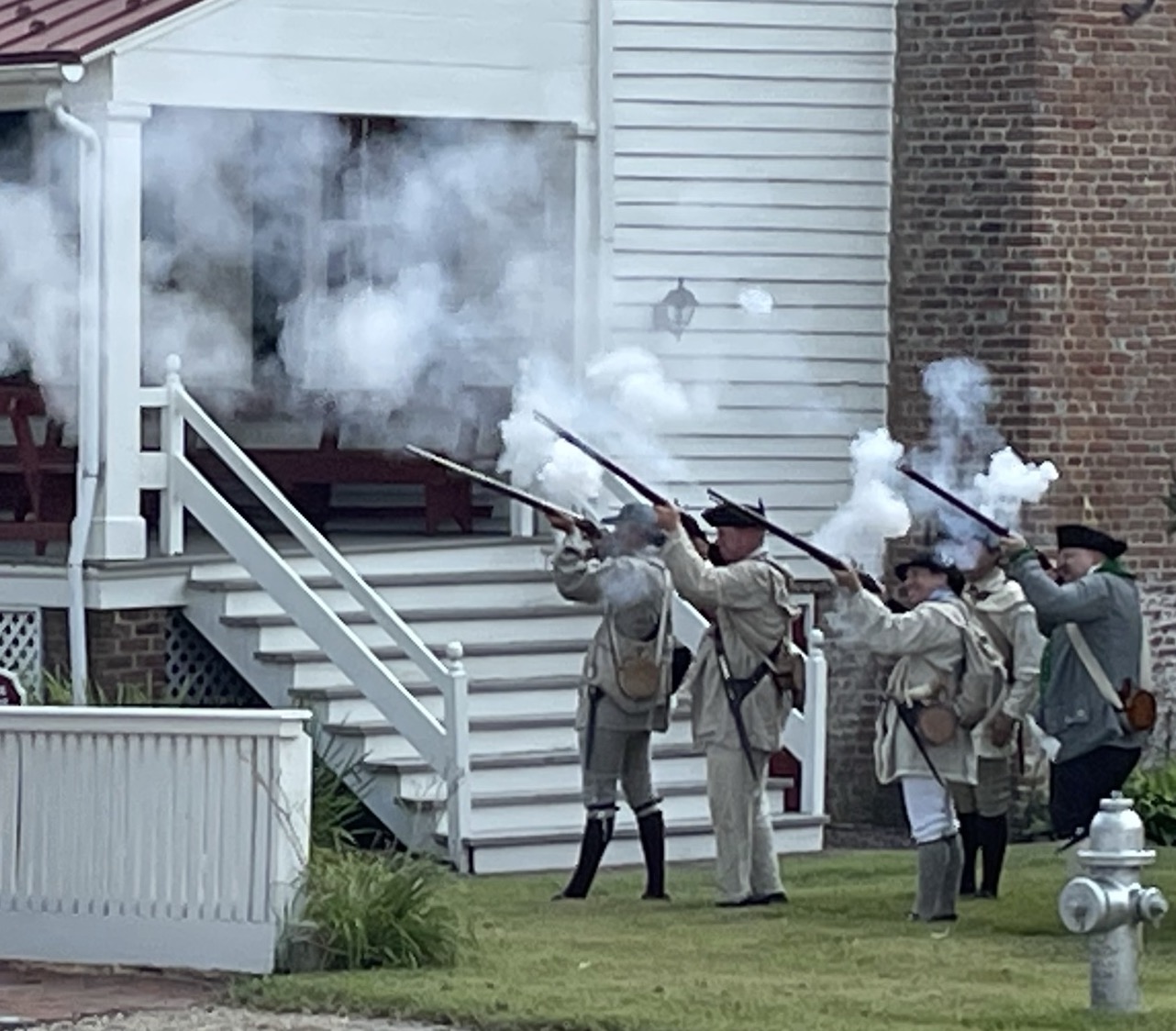
He received a musket salute from re-enactors of the Hanover County Militia.
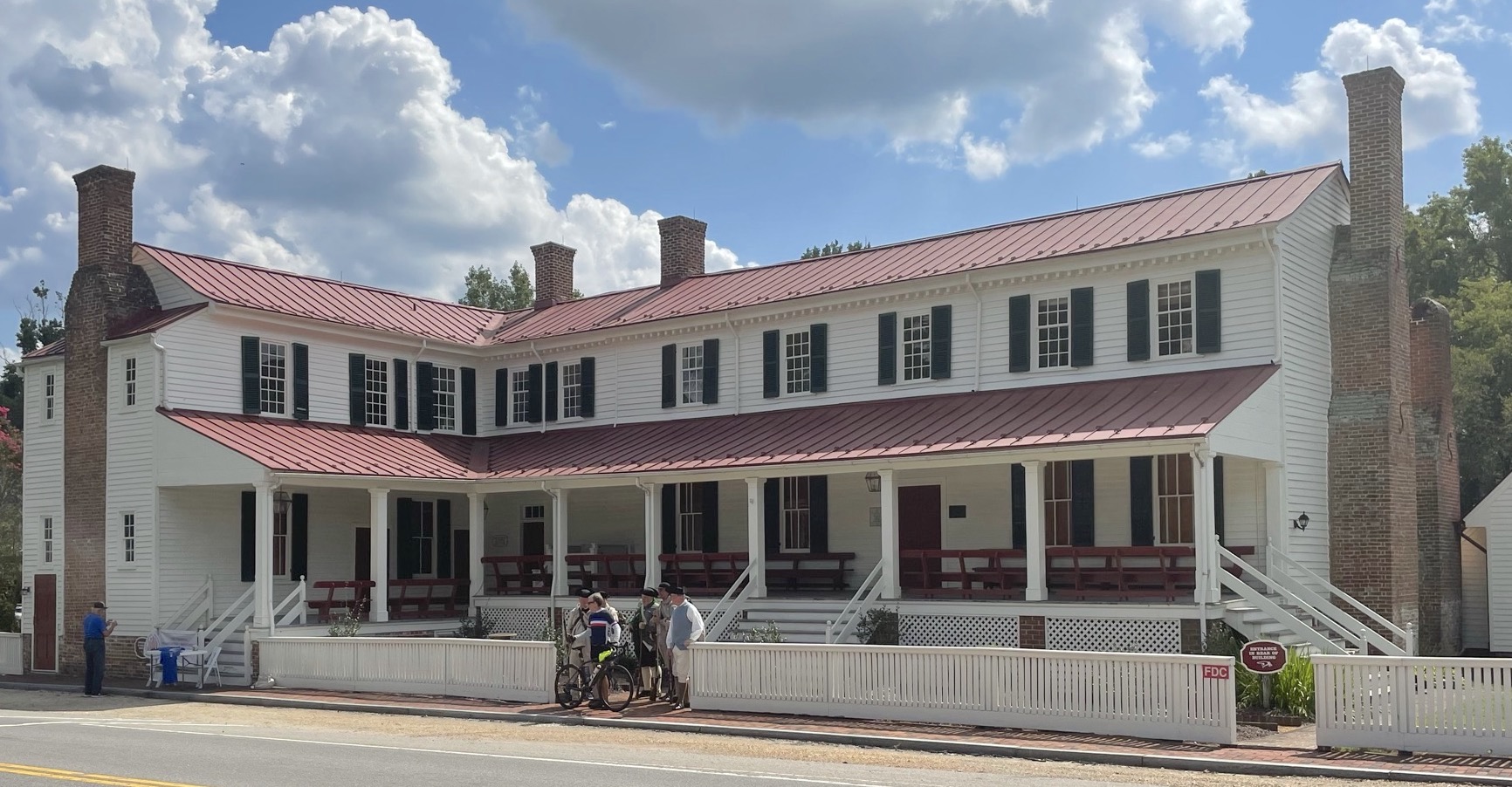
Full view of the Hanover Tavern, which has been serving the public
since the early 1700s and now houses a theater, a restaurant, and a bar.
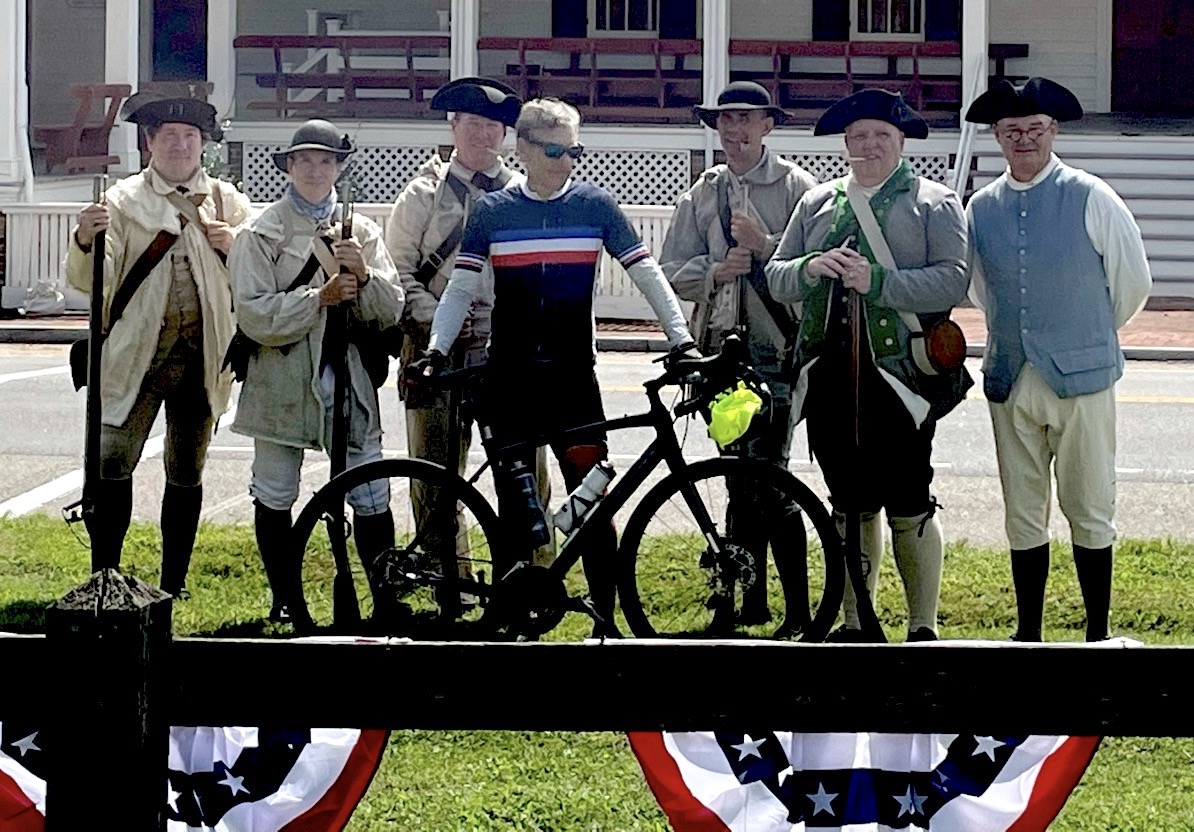
Sal spent time with the re-enactors, then adjourned with Jeff for dinner
with Dave and Sam Meredith (see offices above)
and Jennifer Wampler, Director of trails
for the Virginia Department of Recreation and Conservation.
